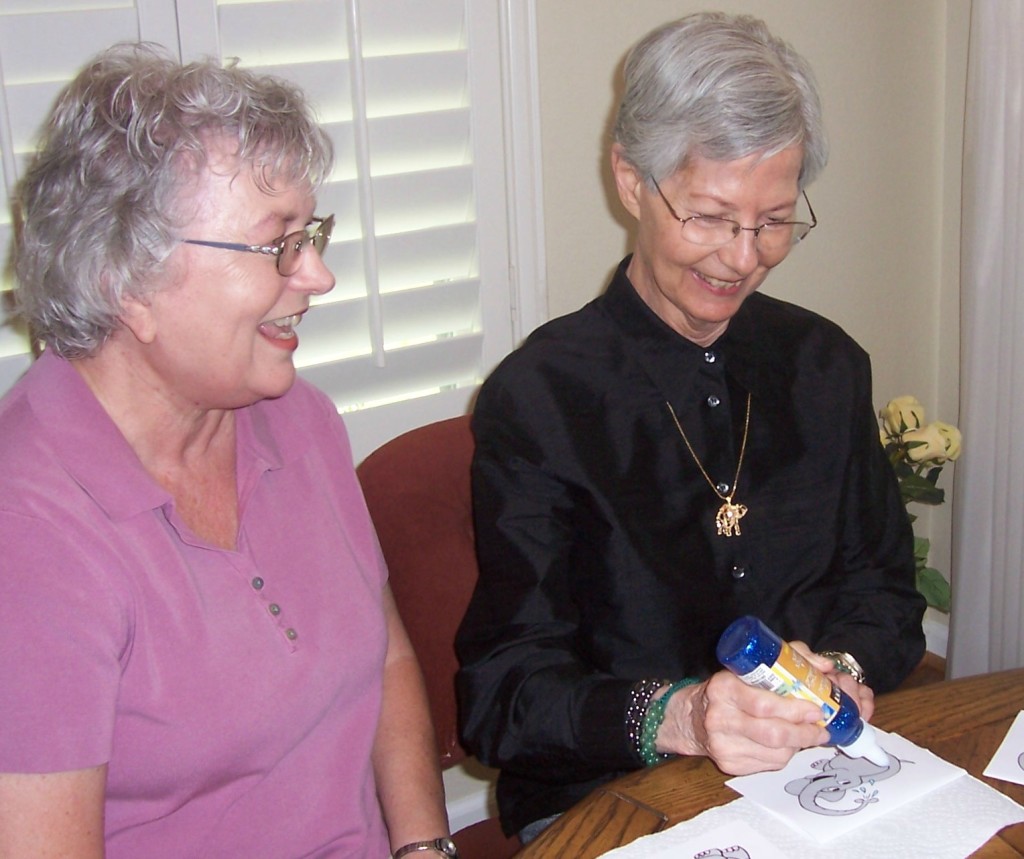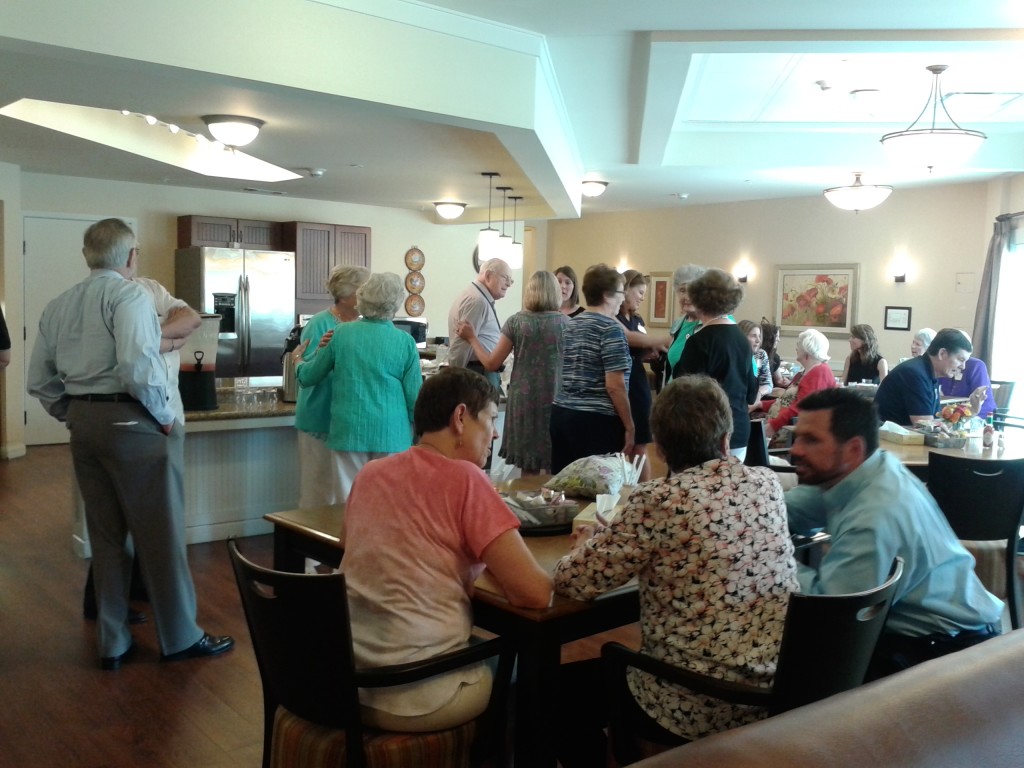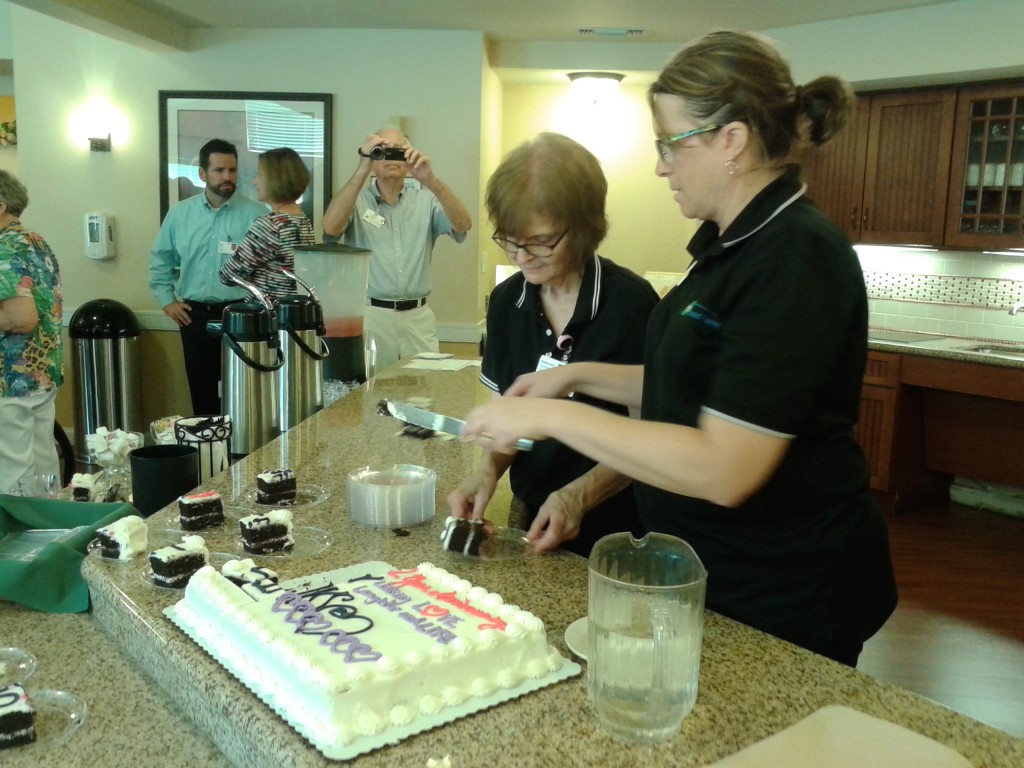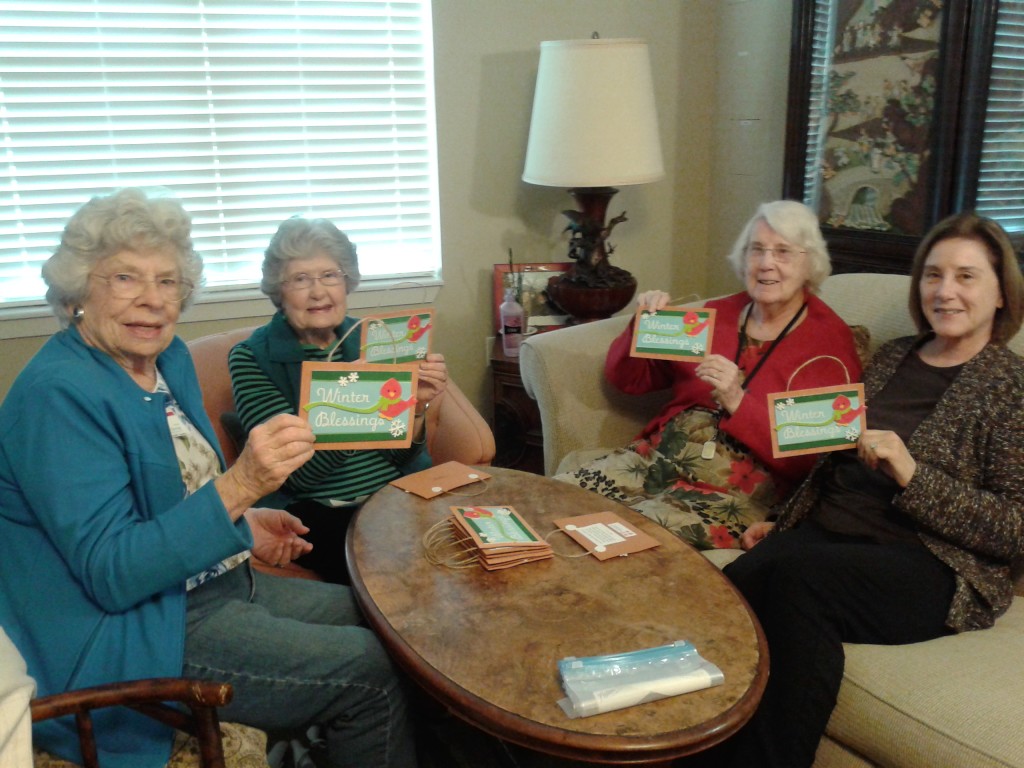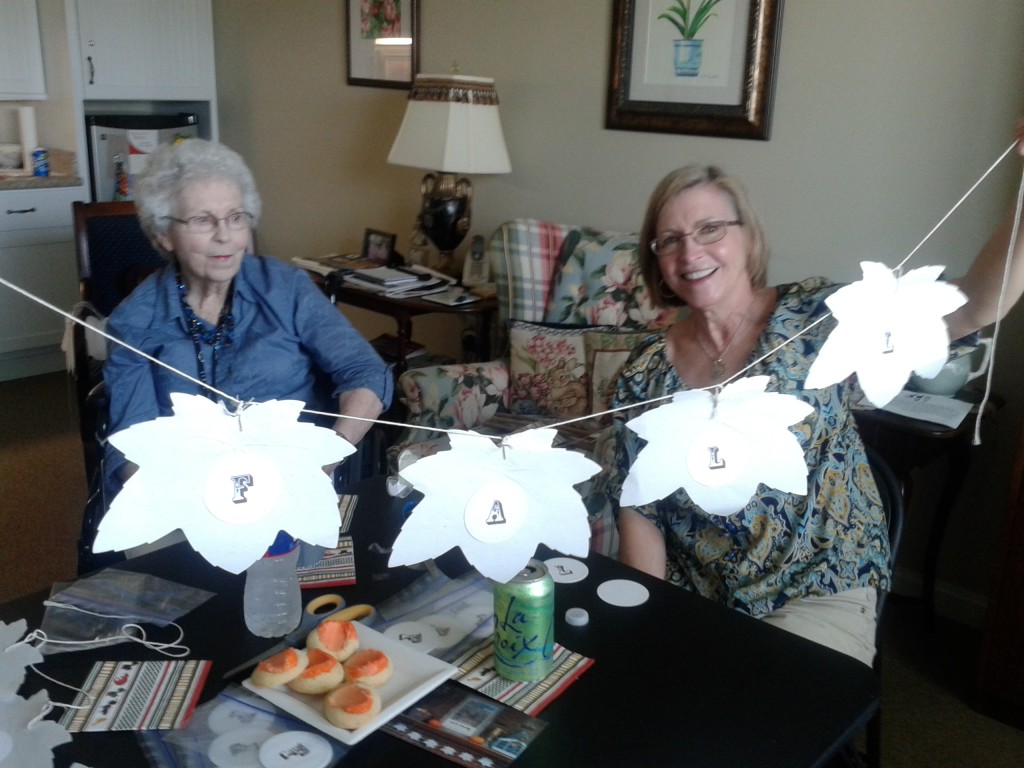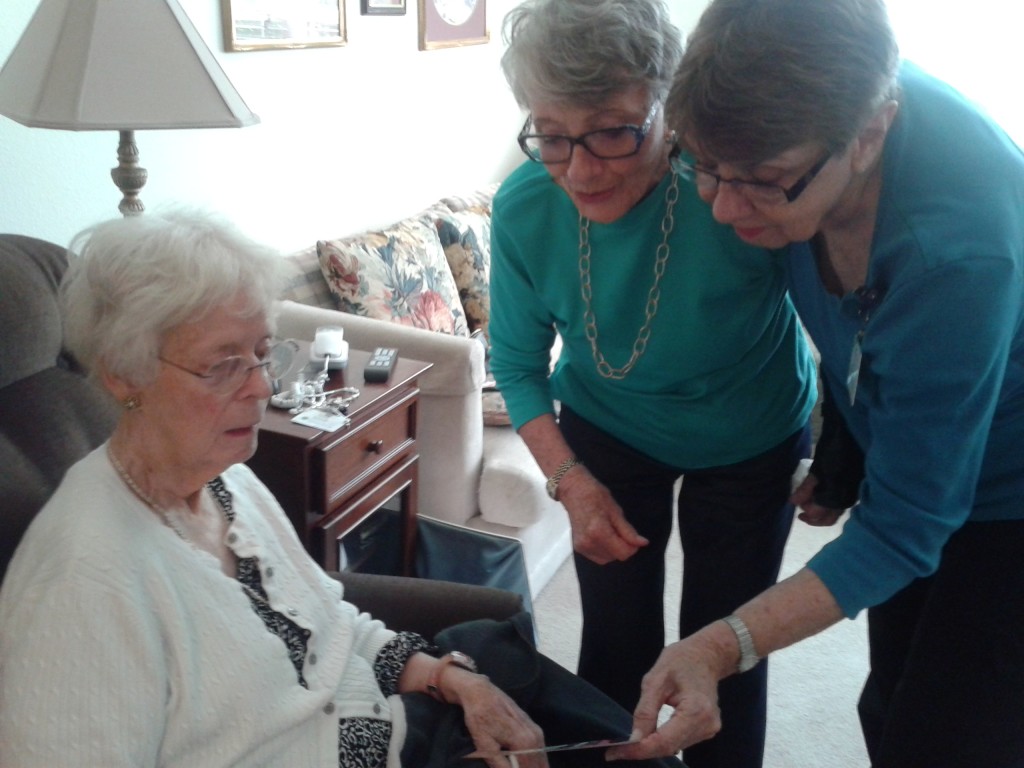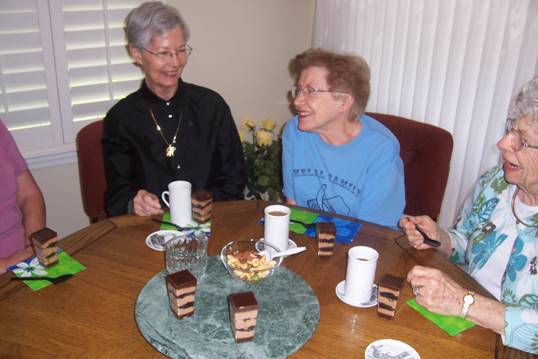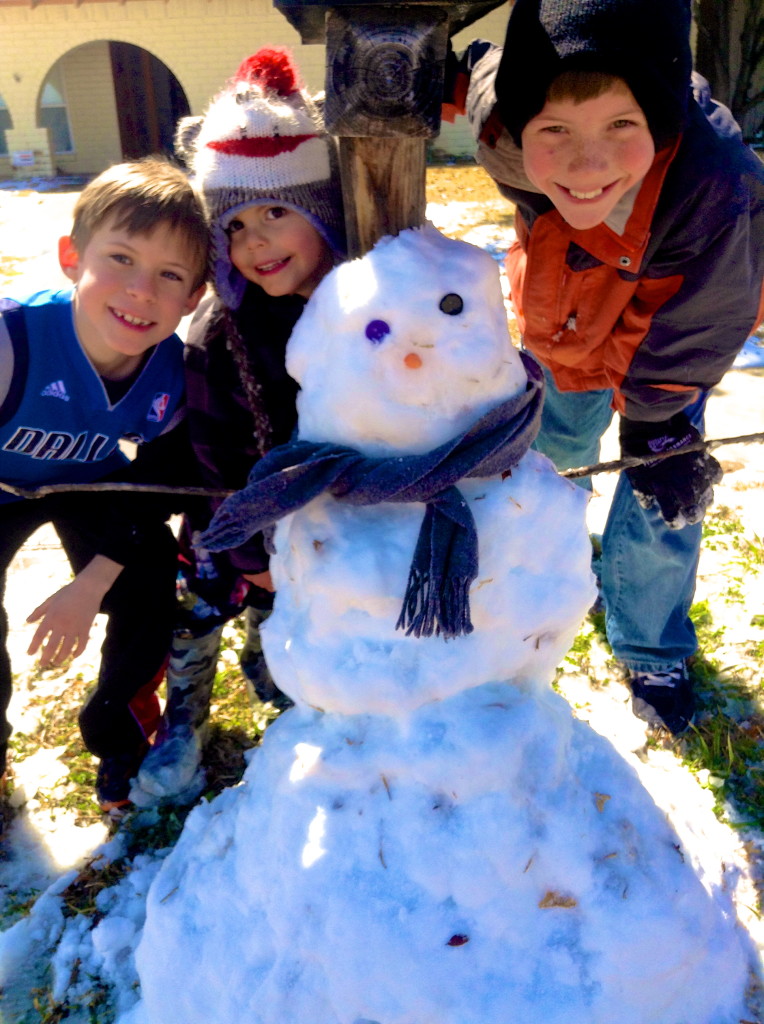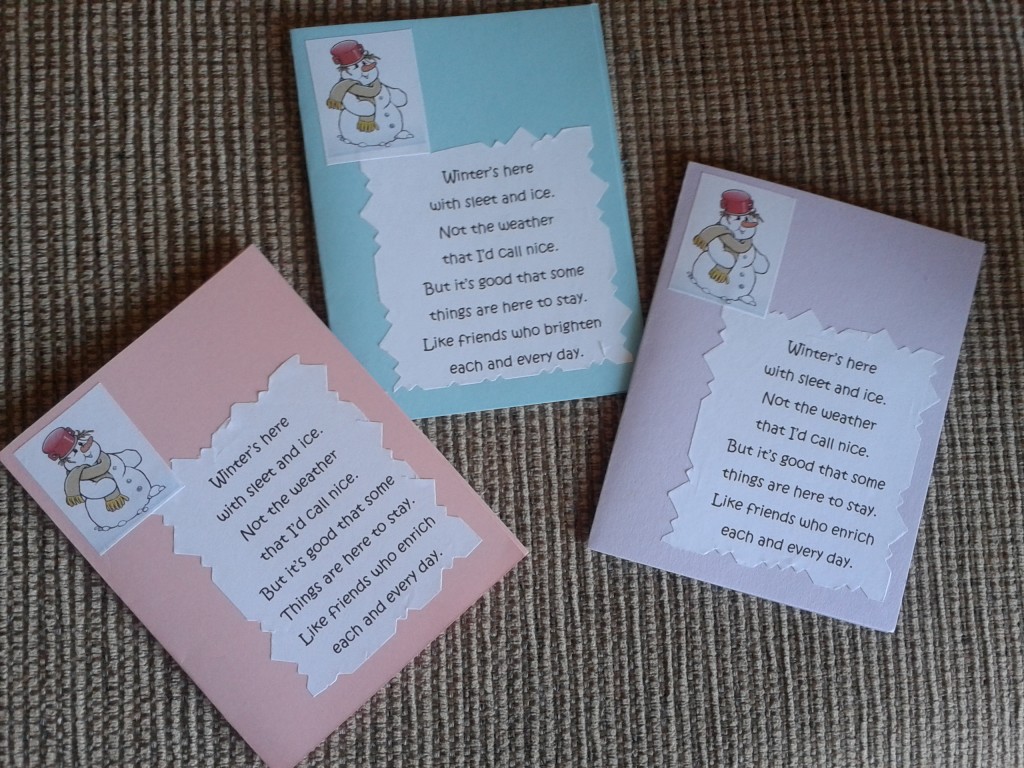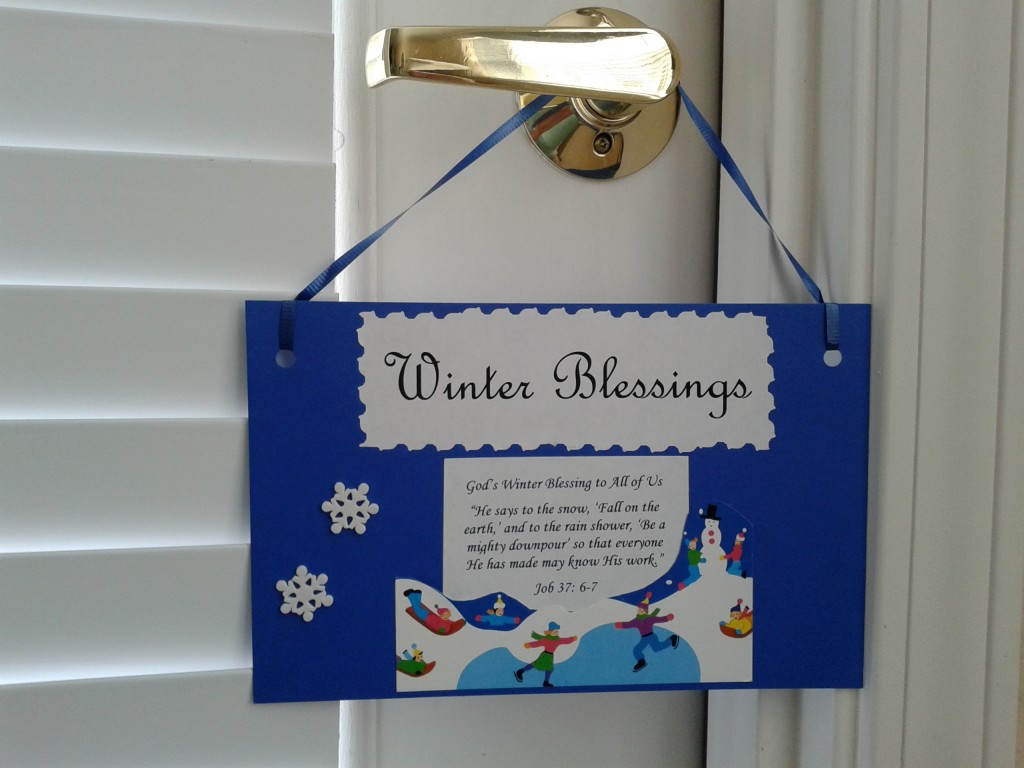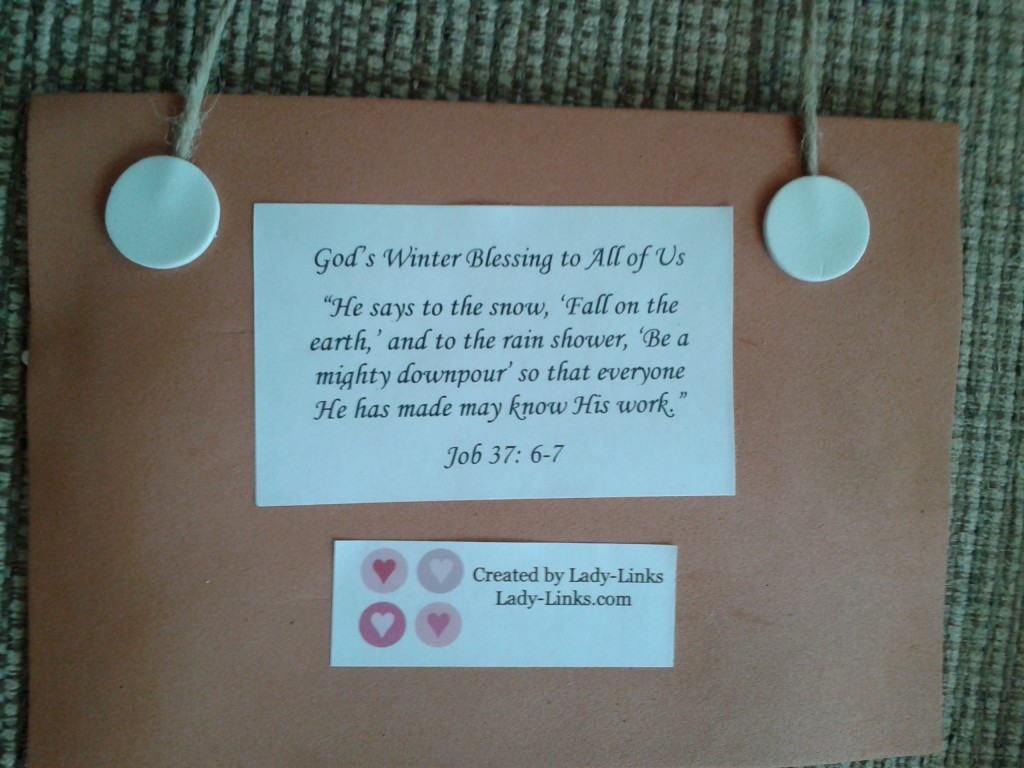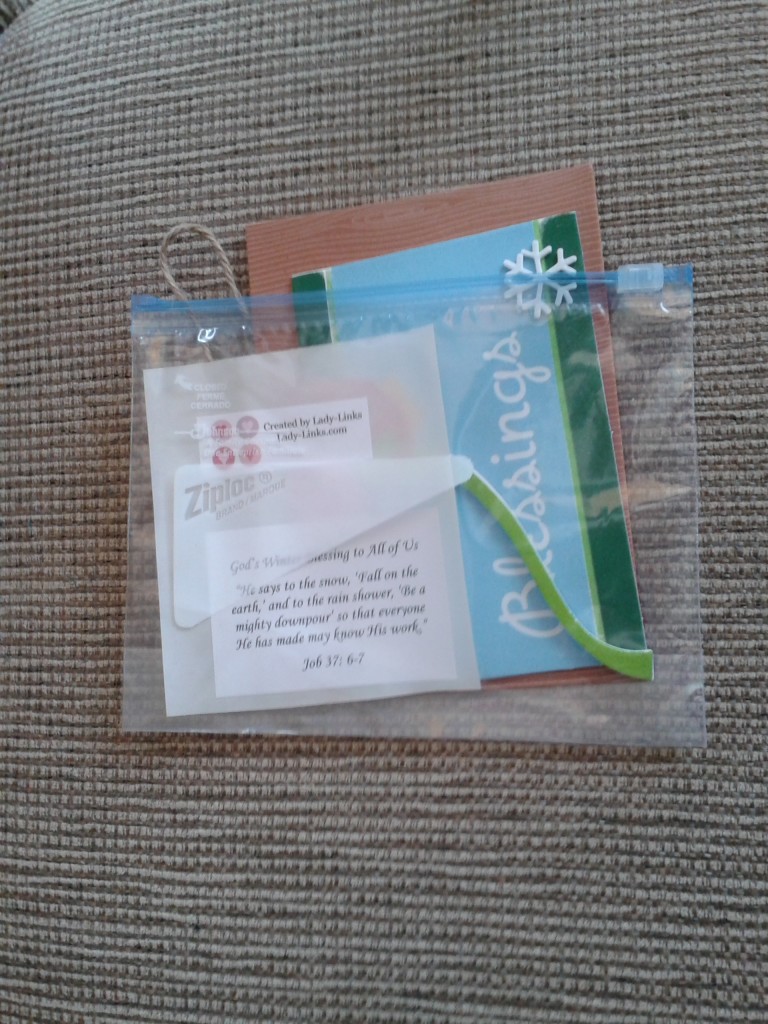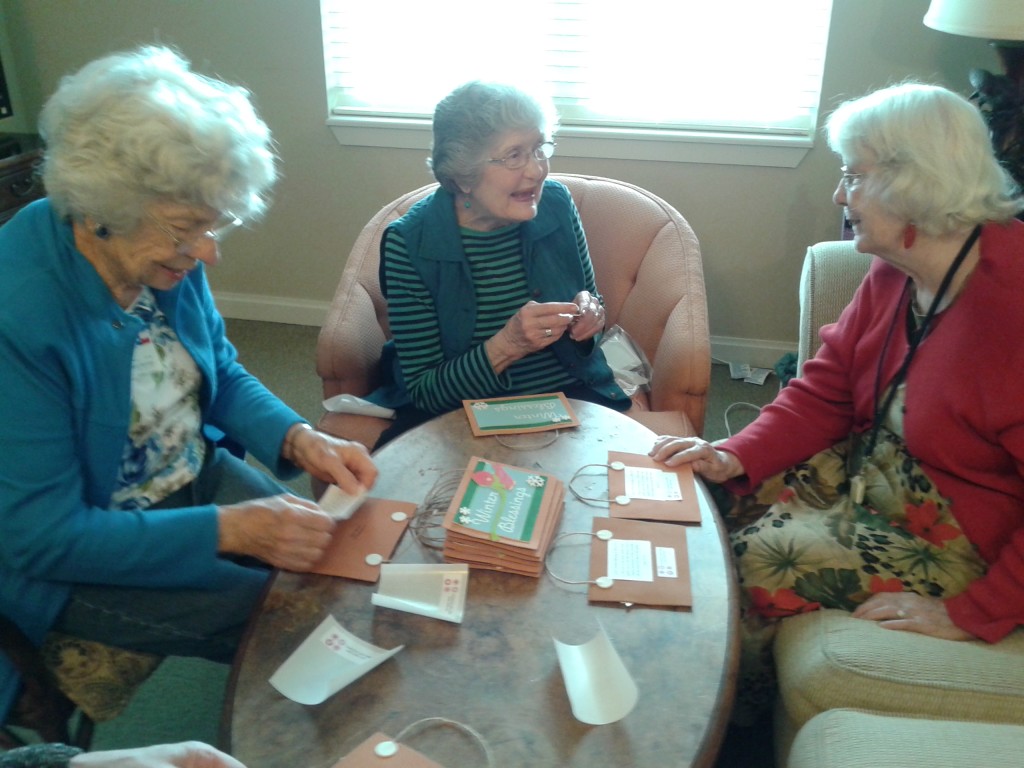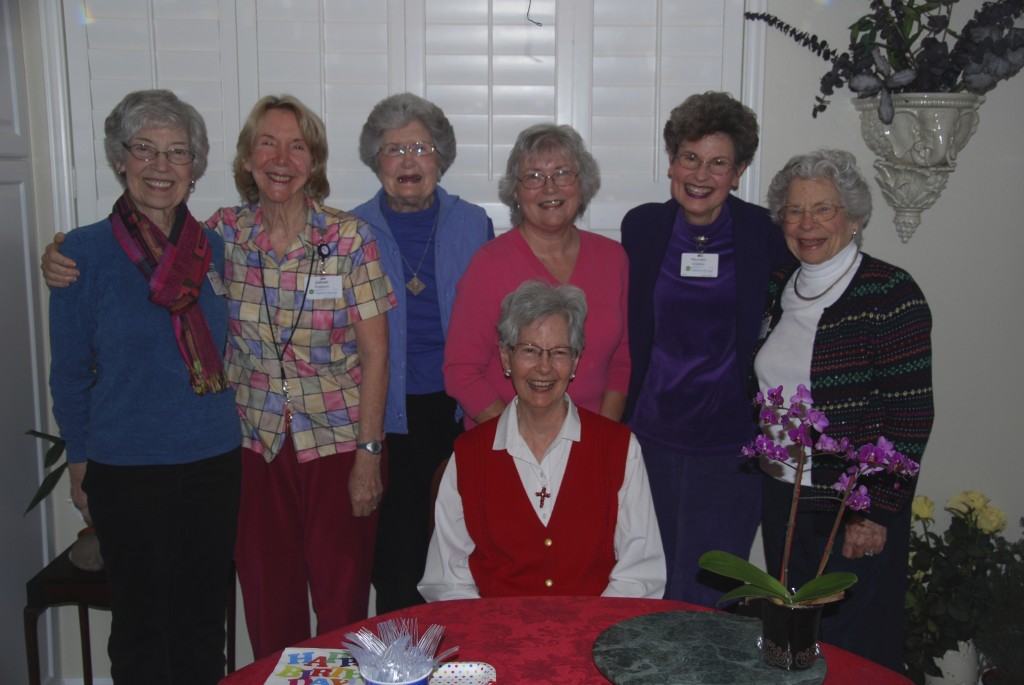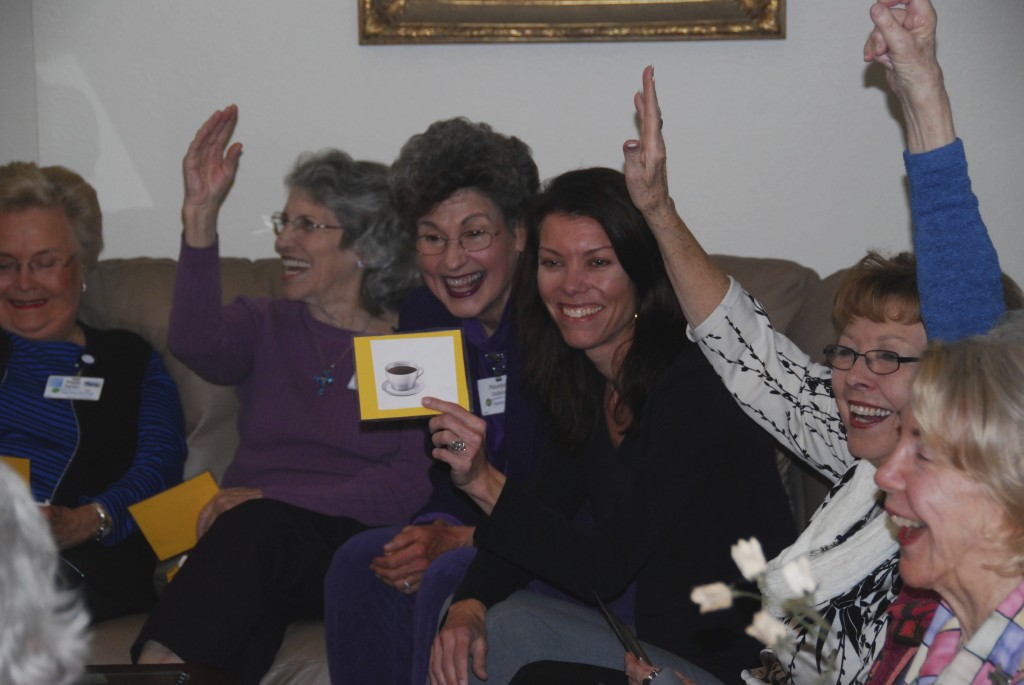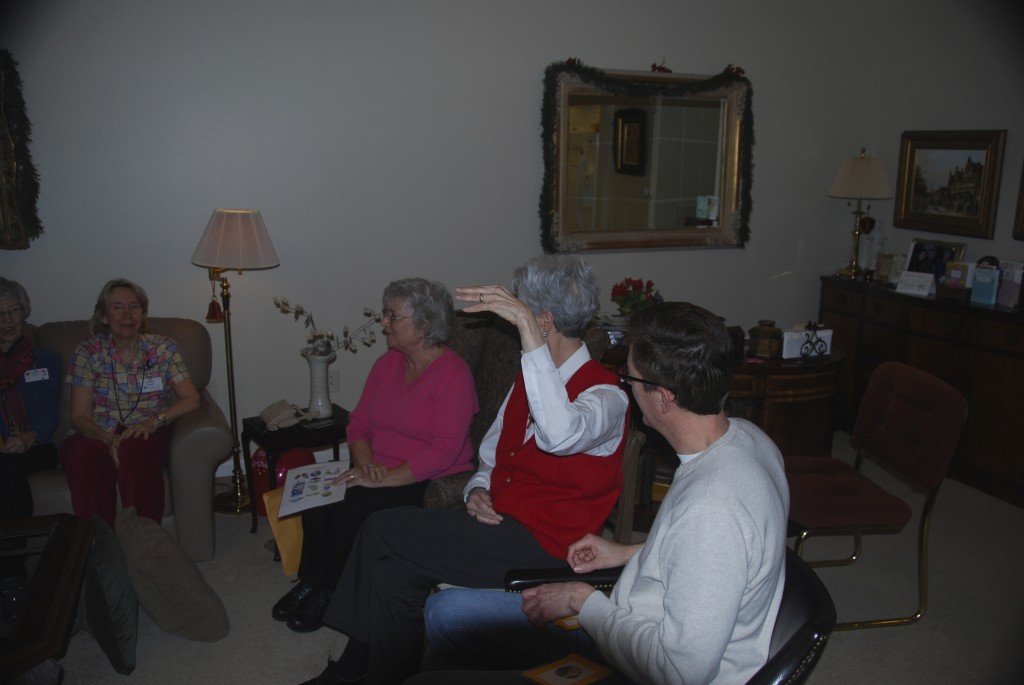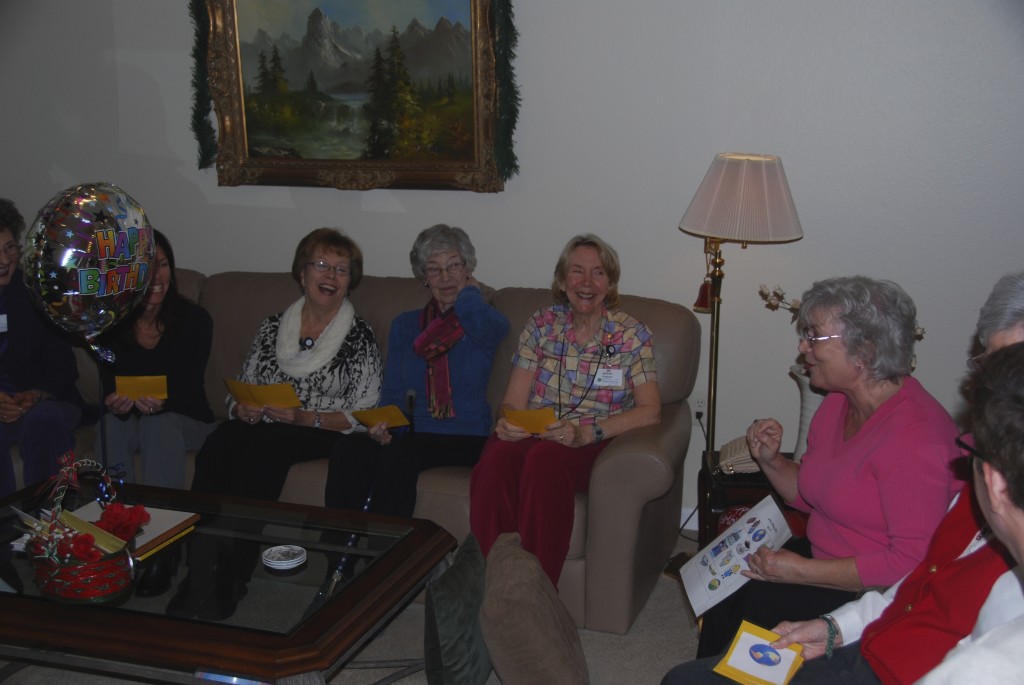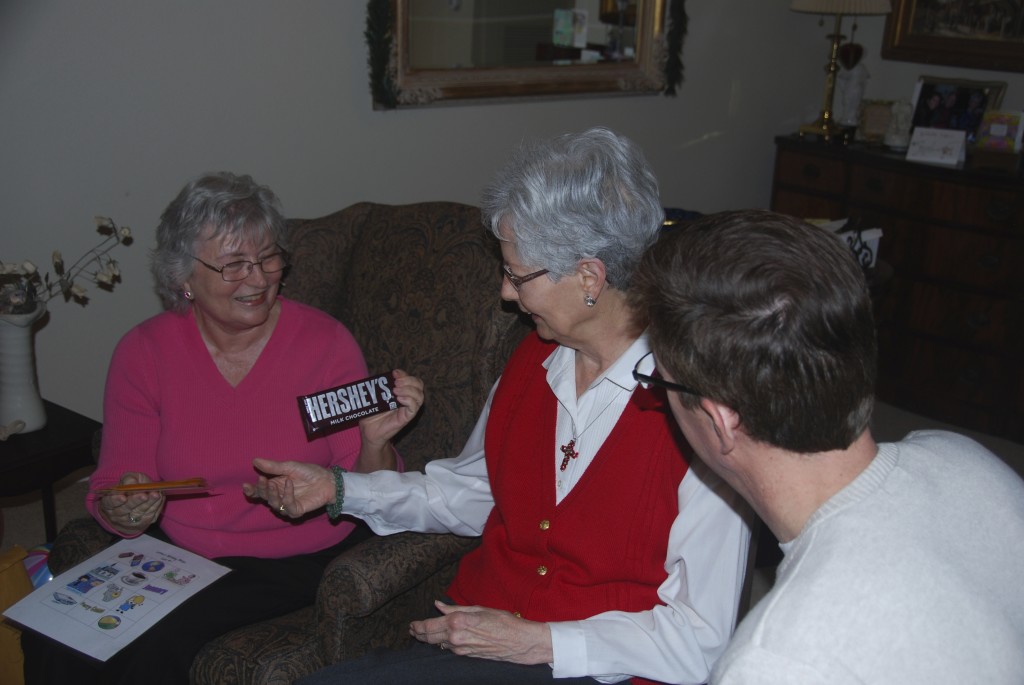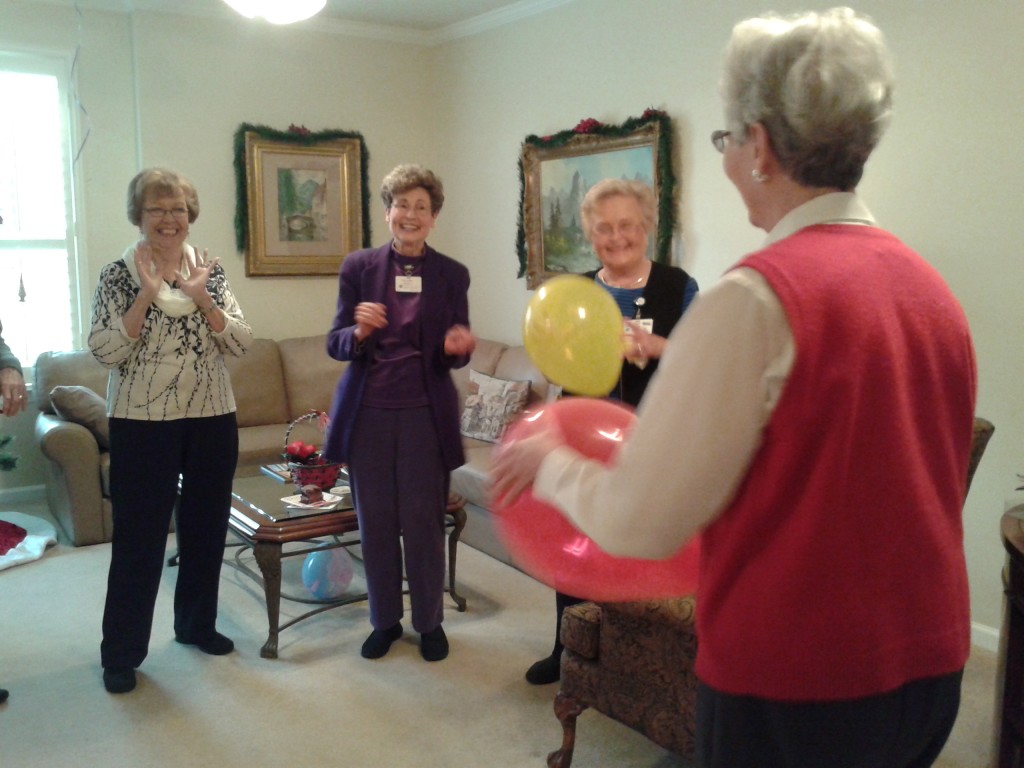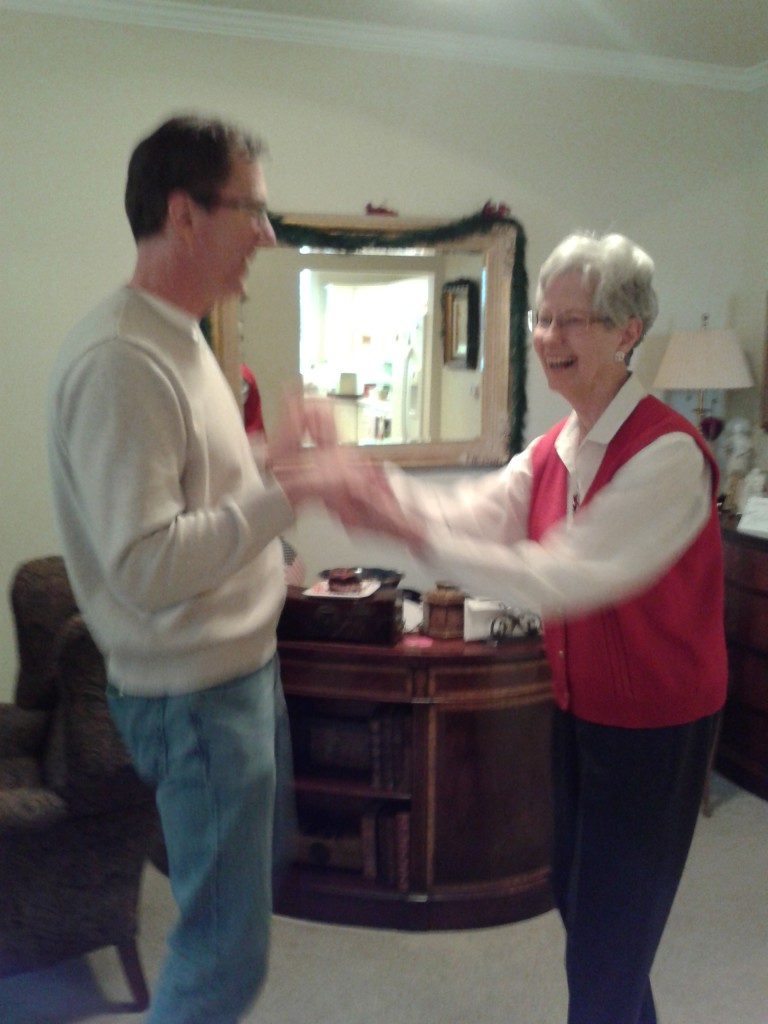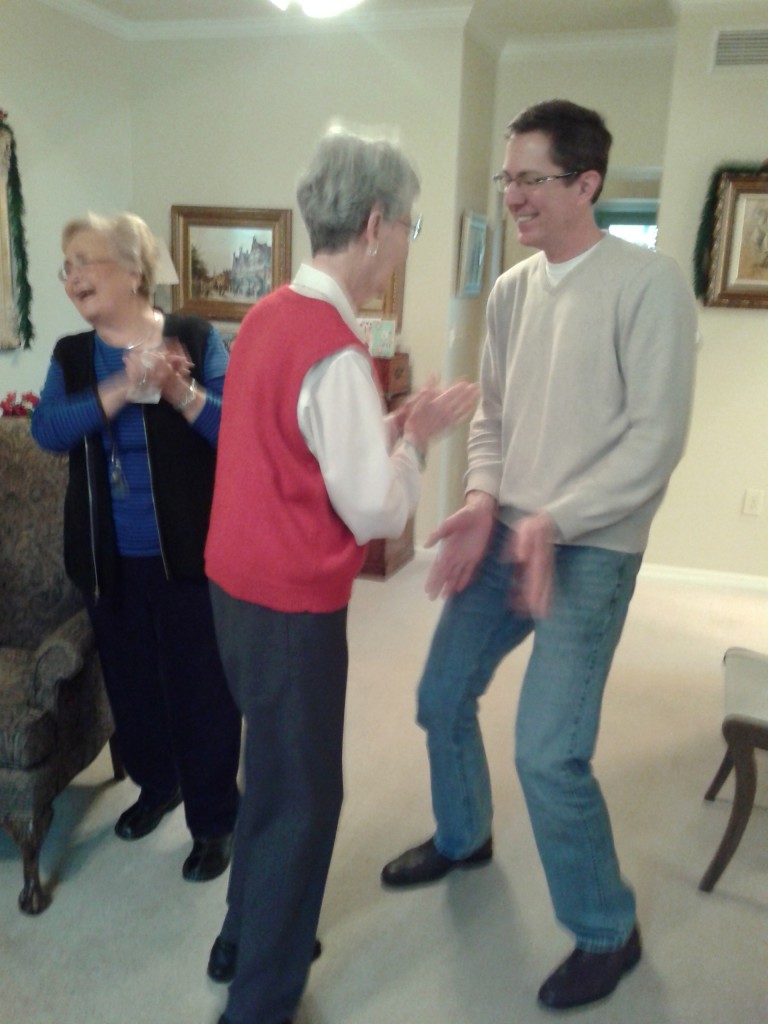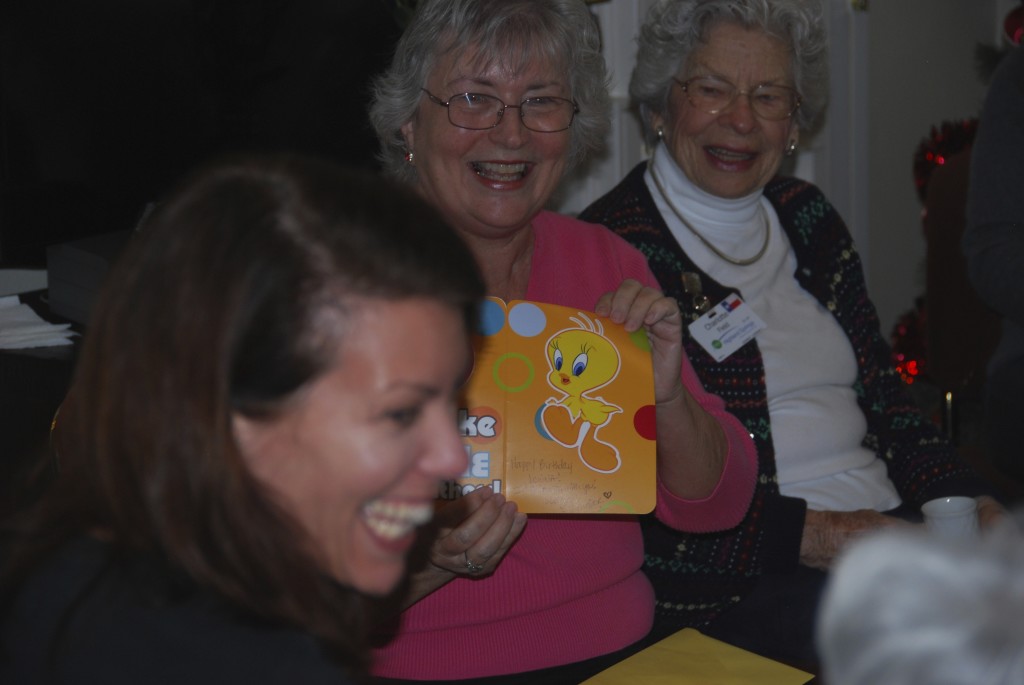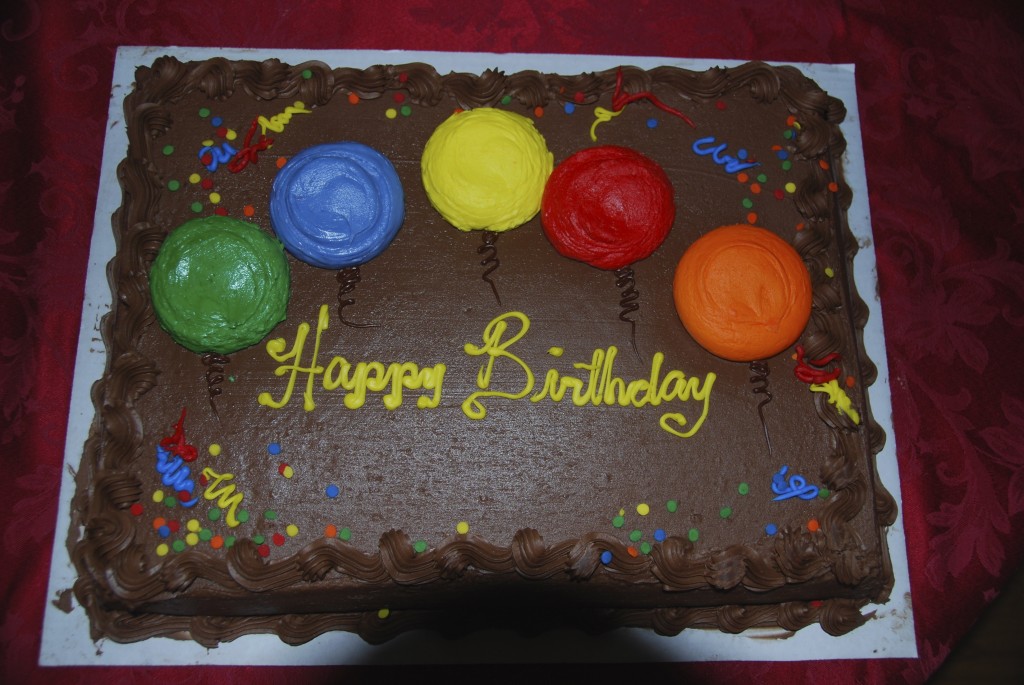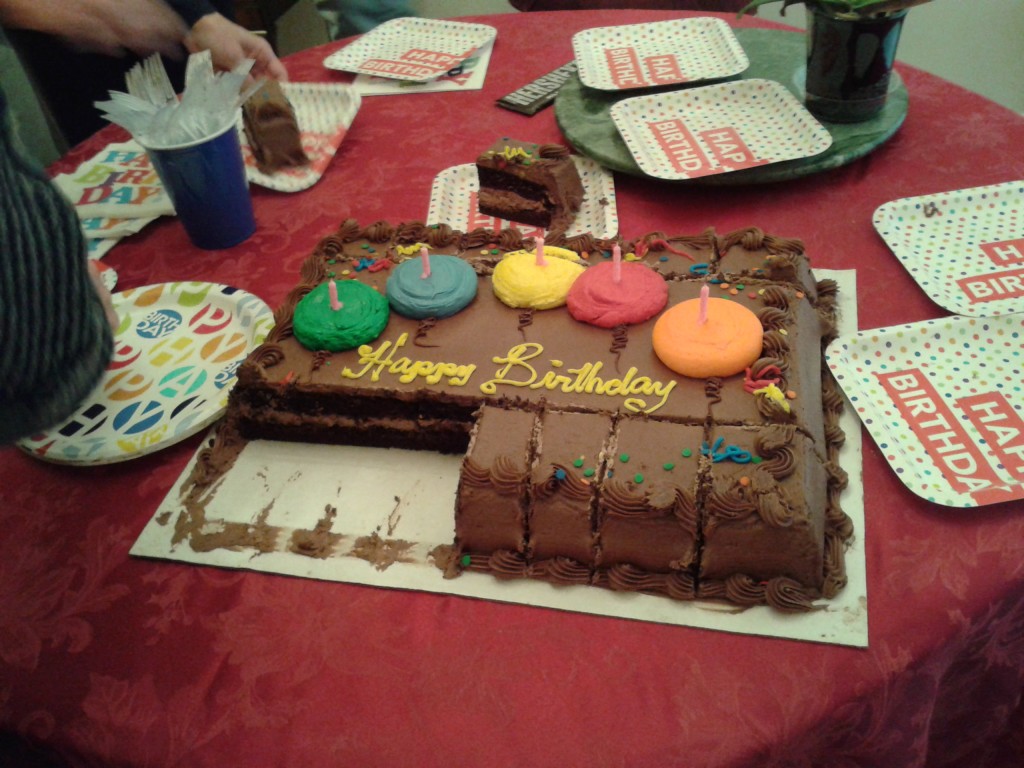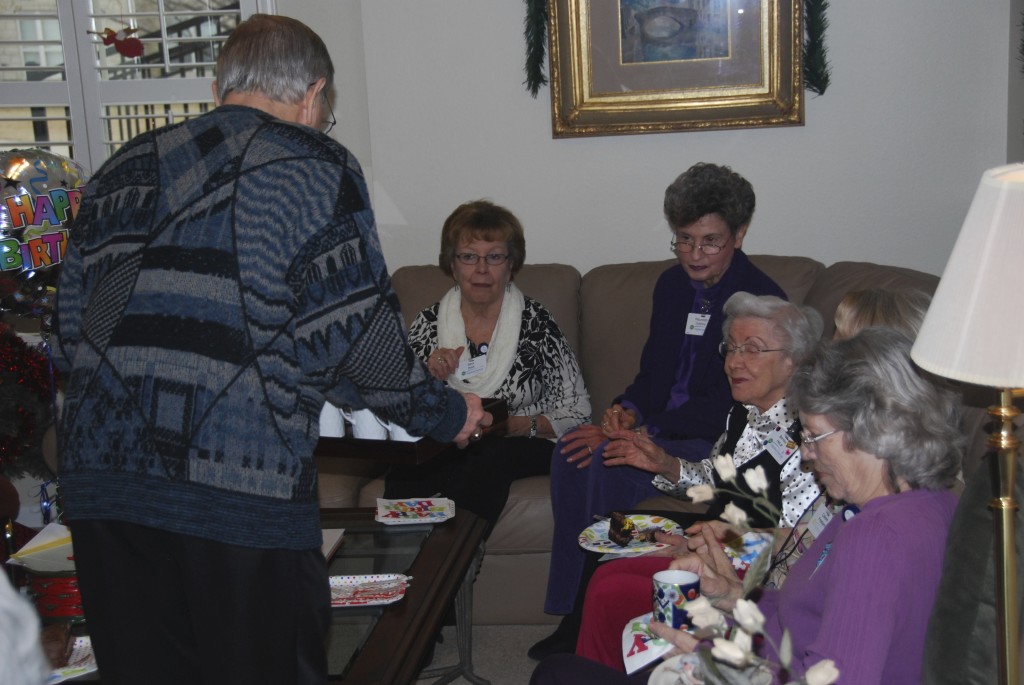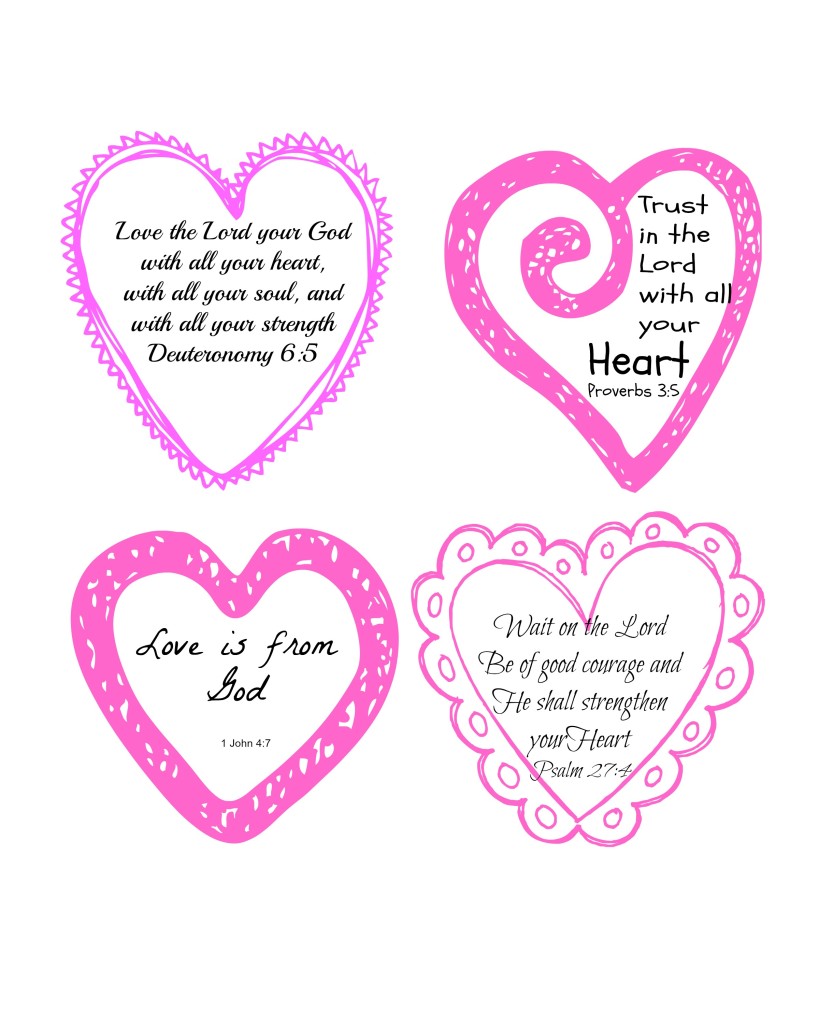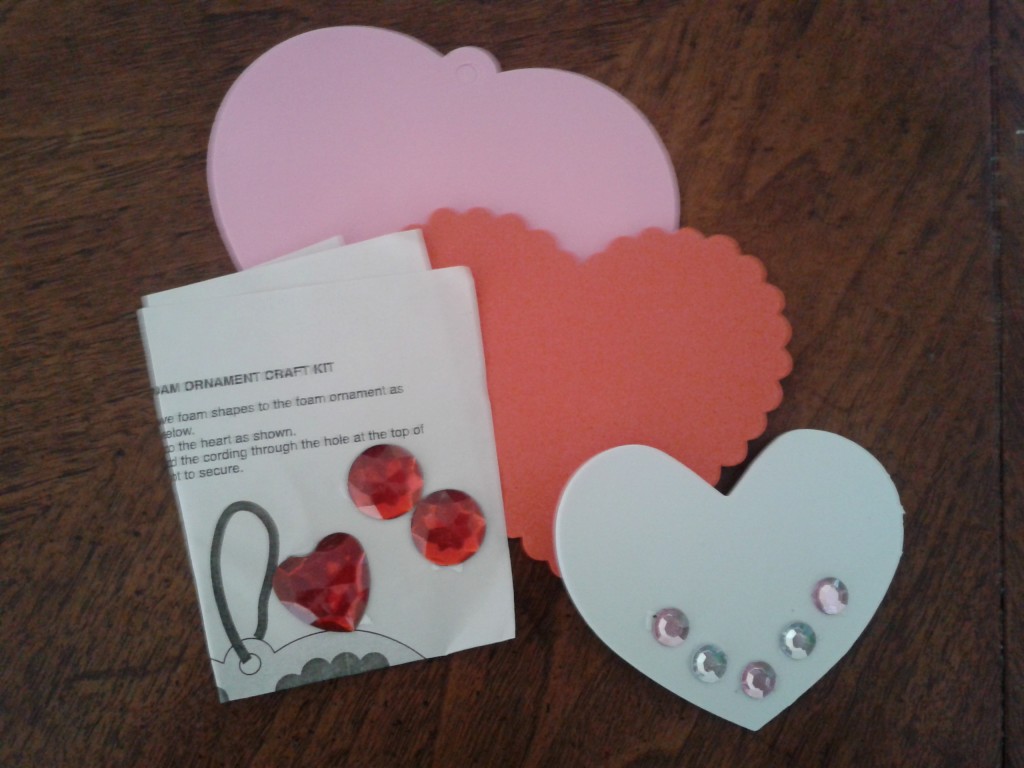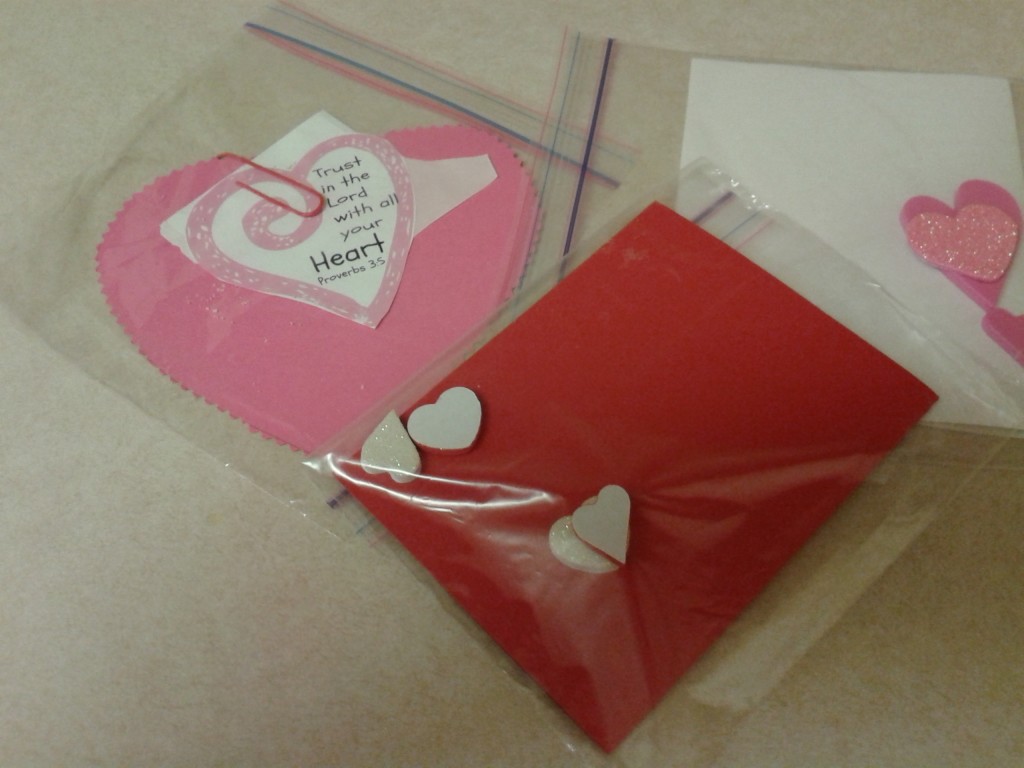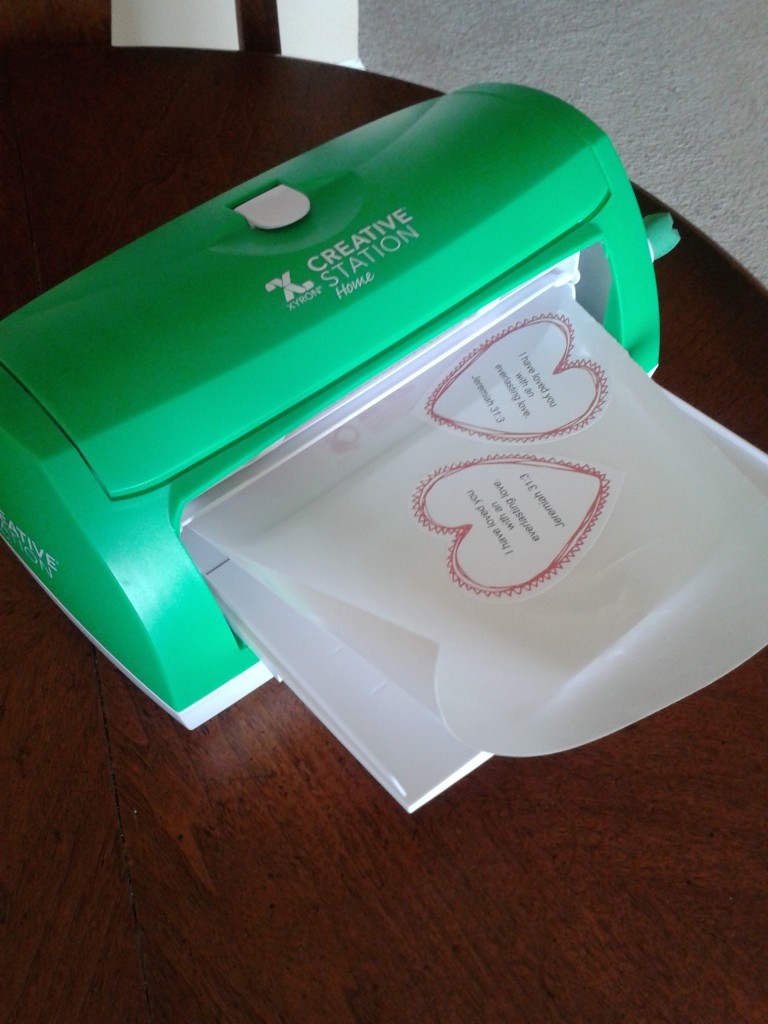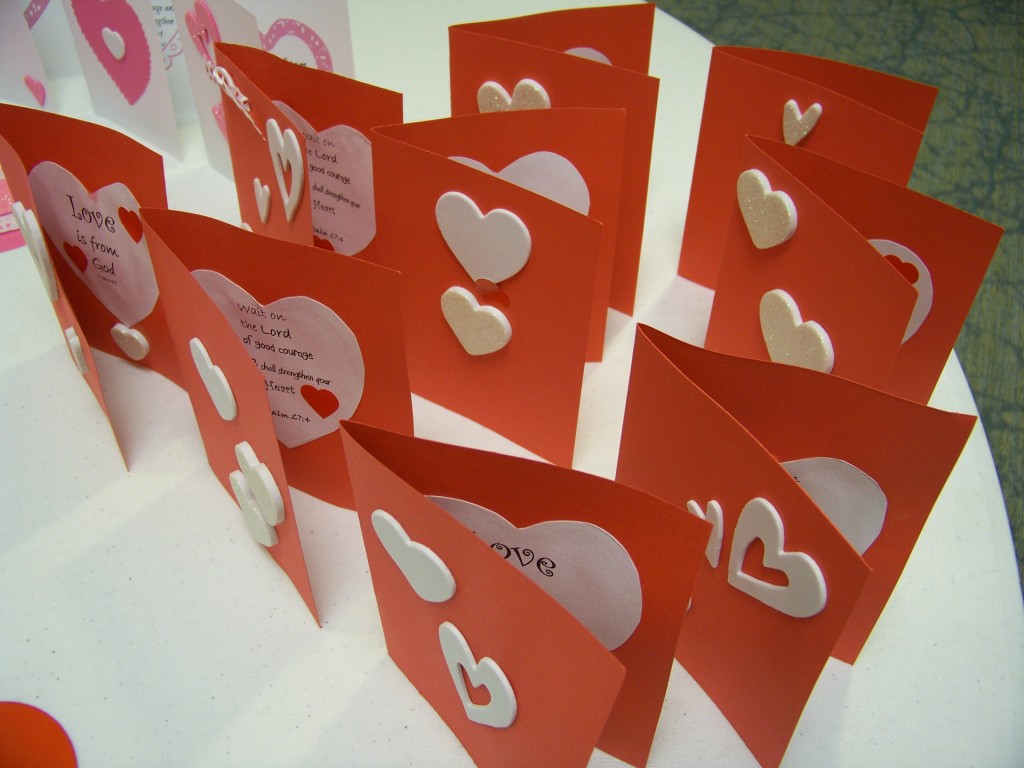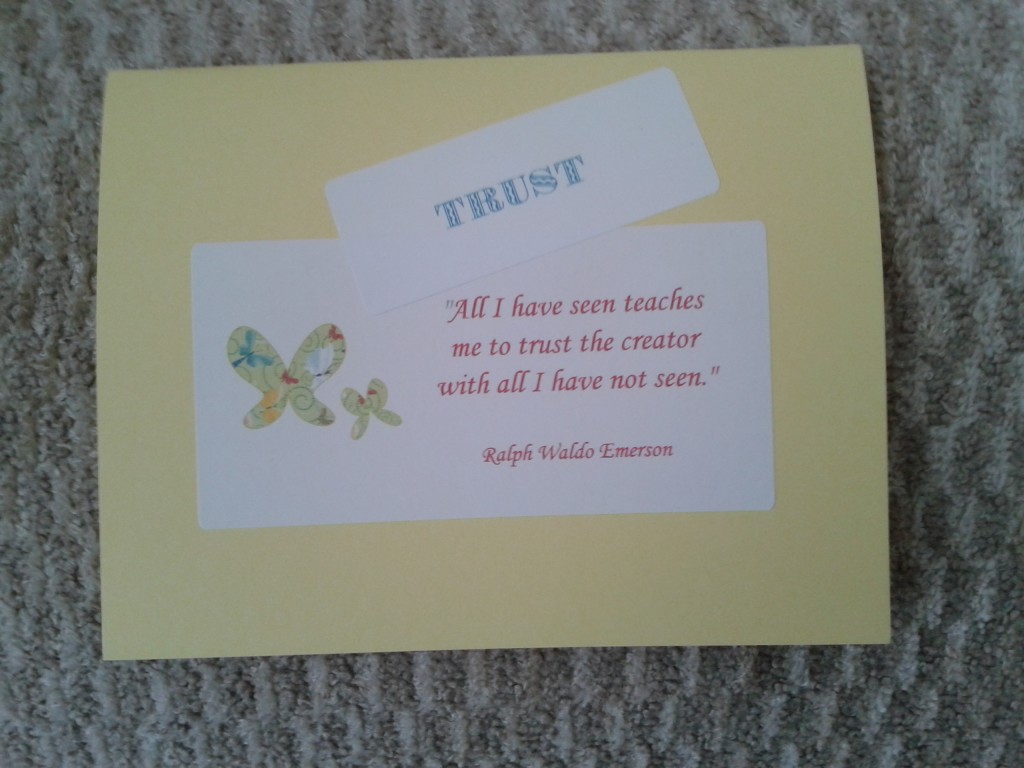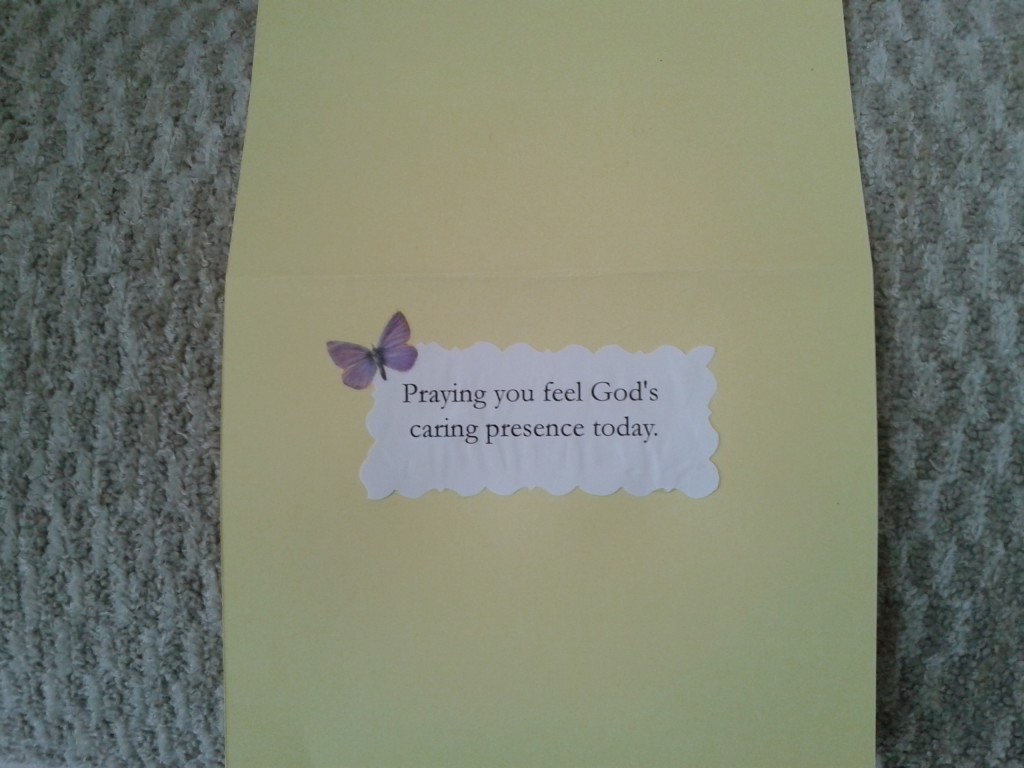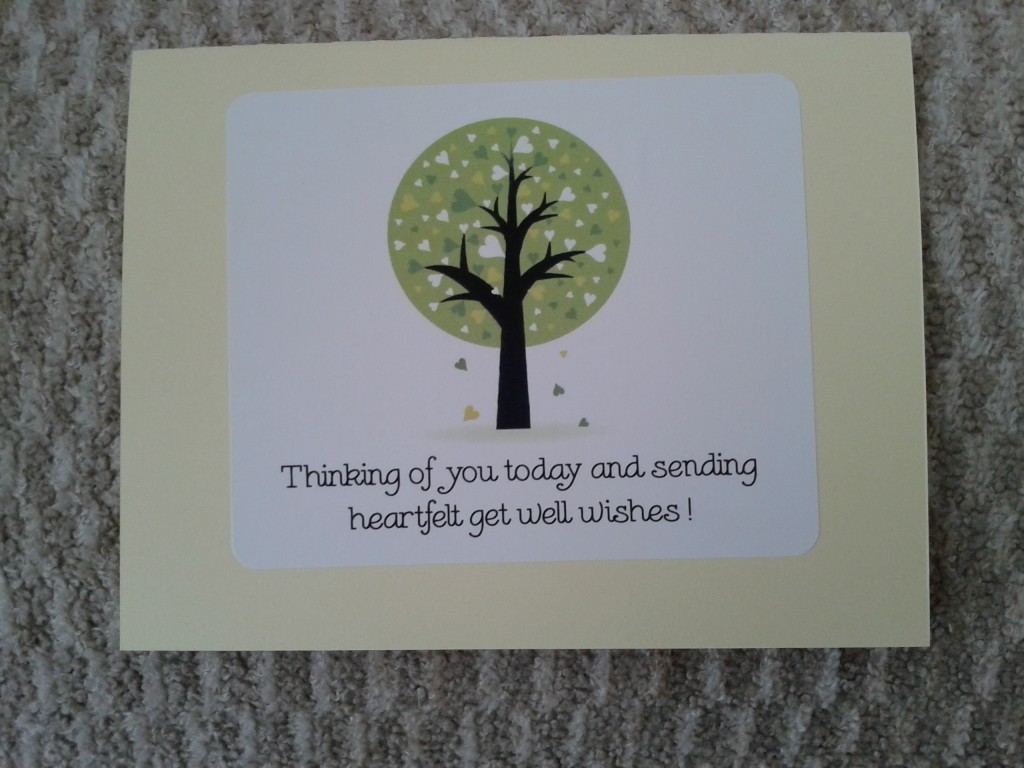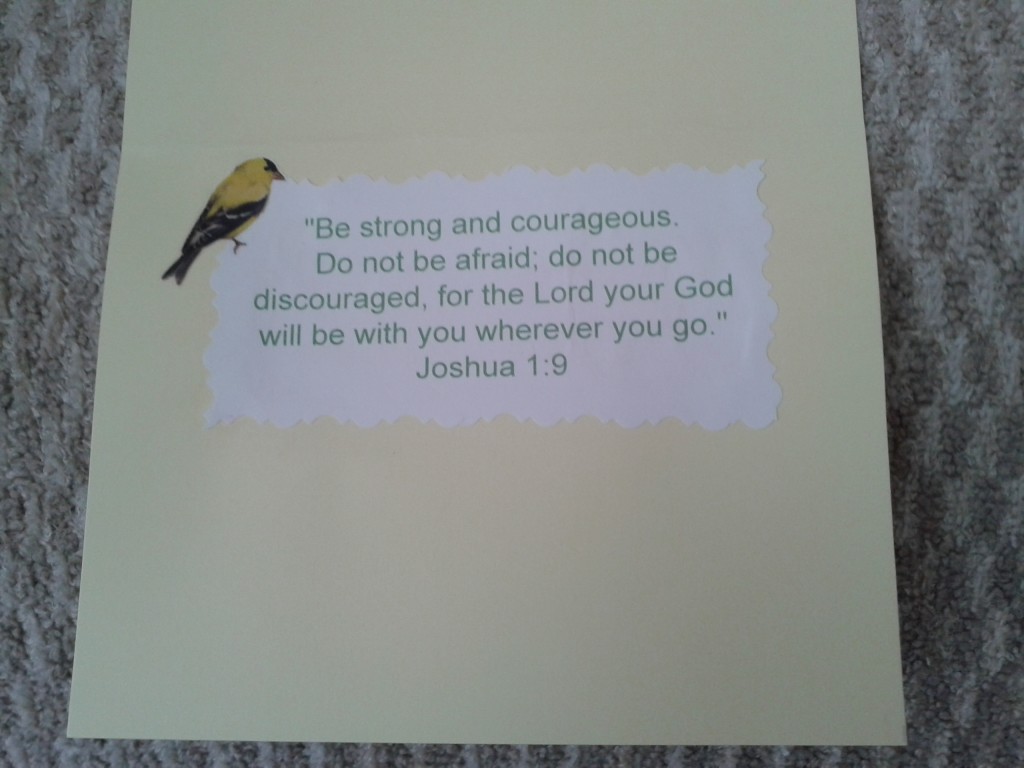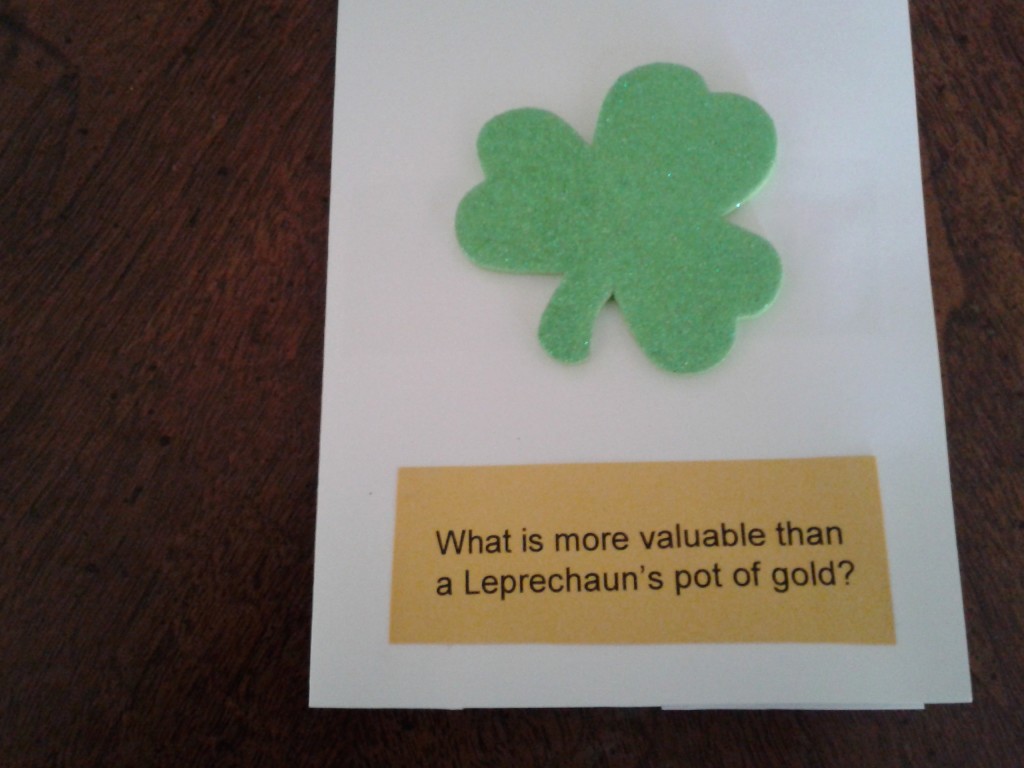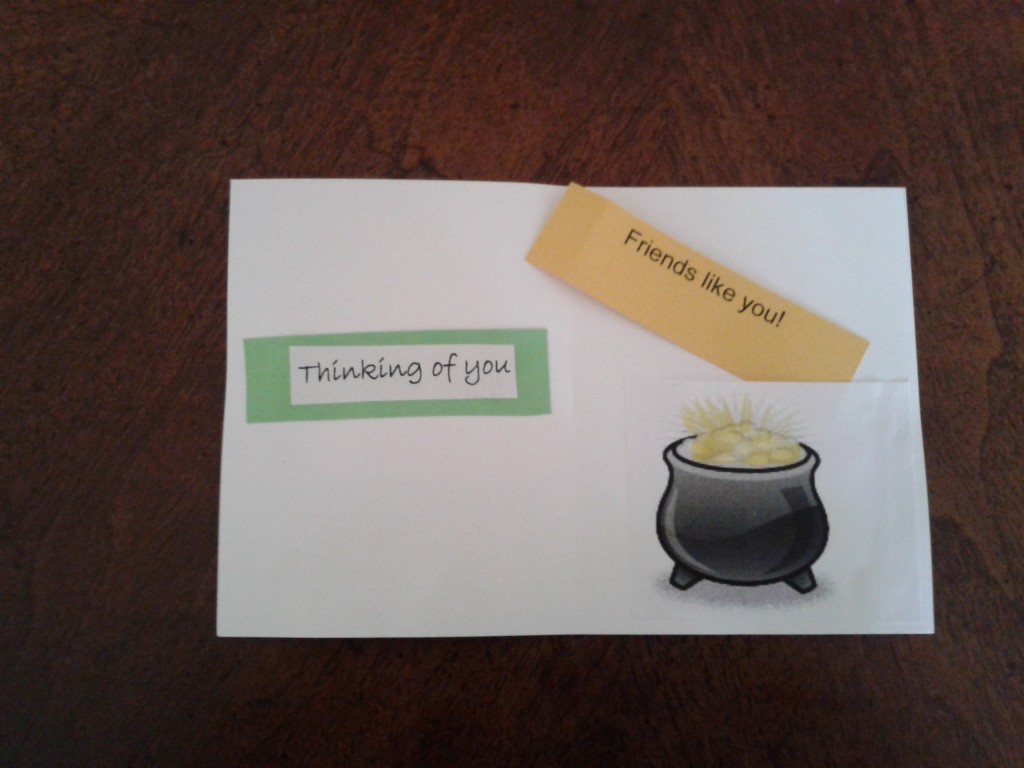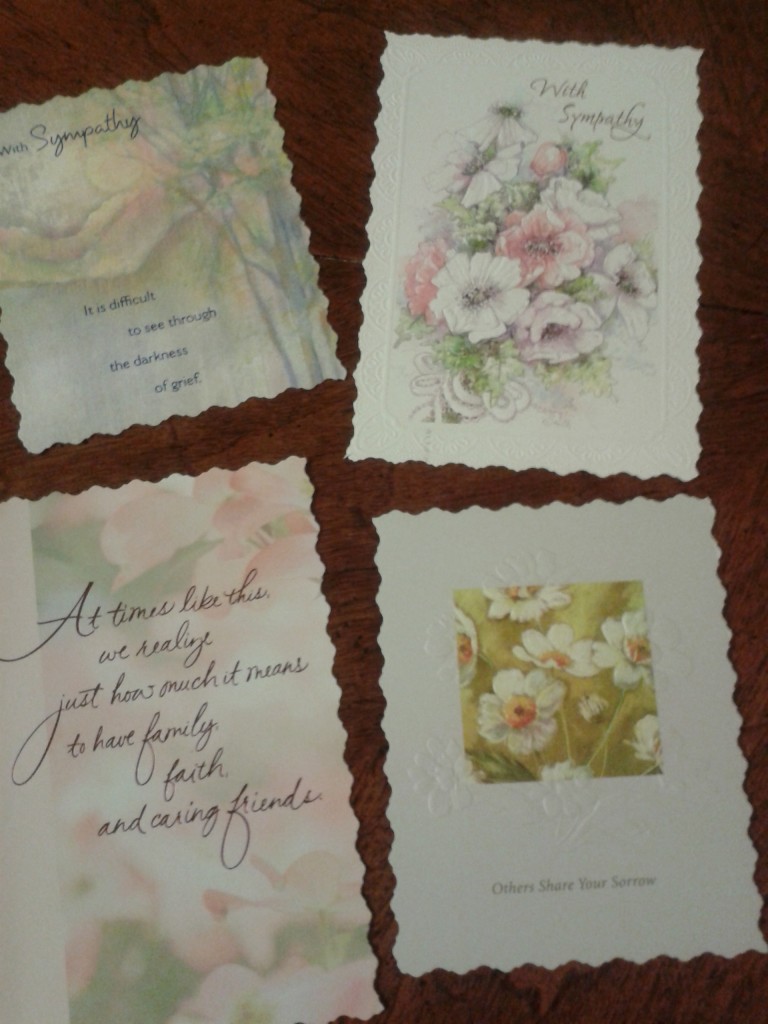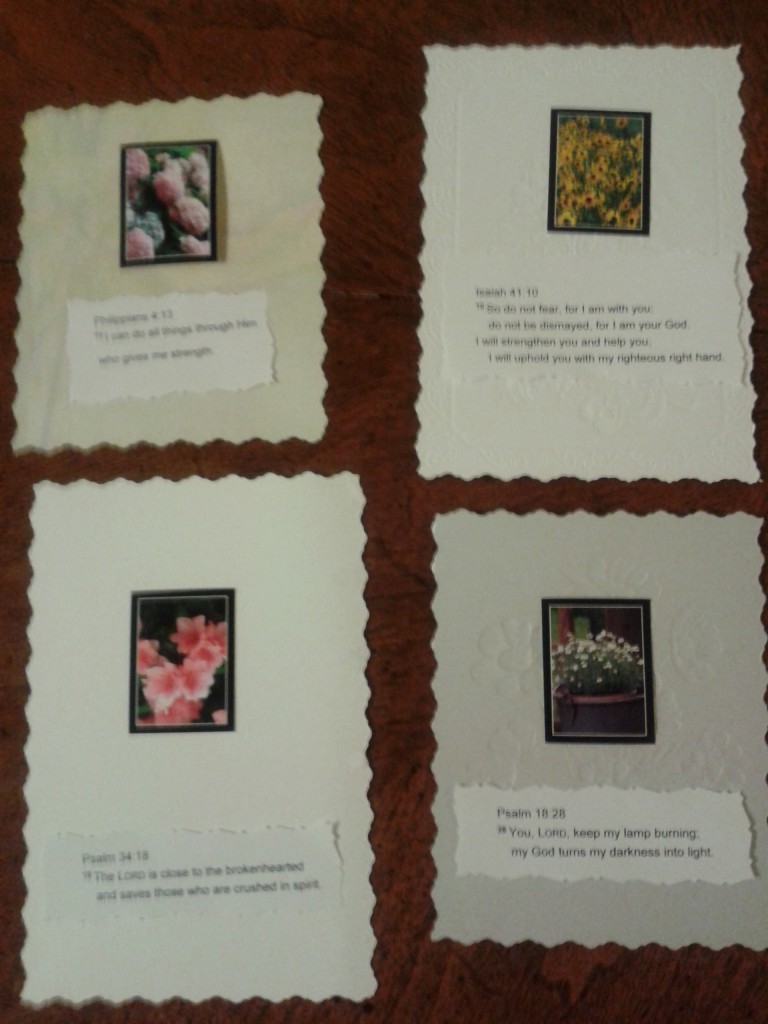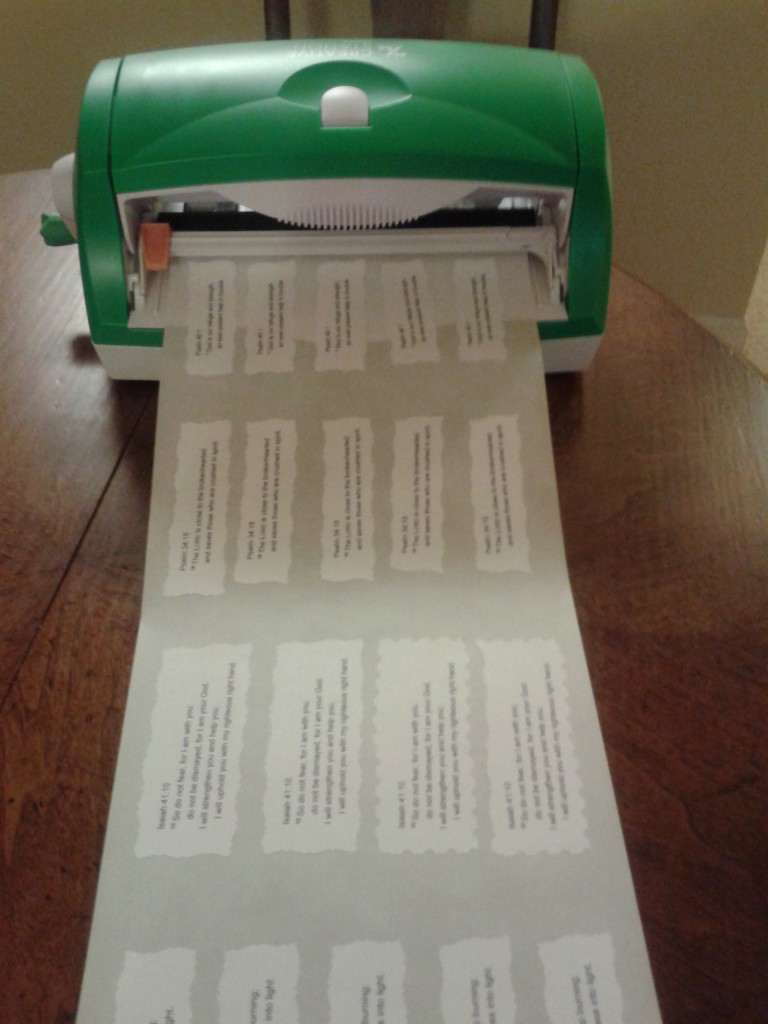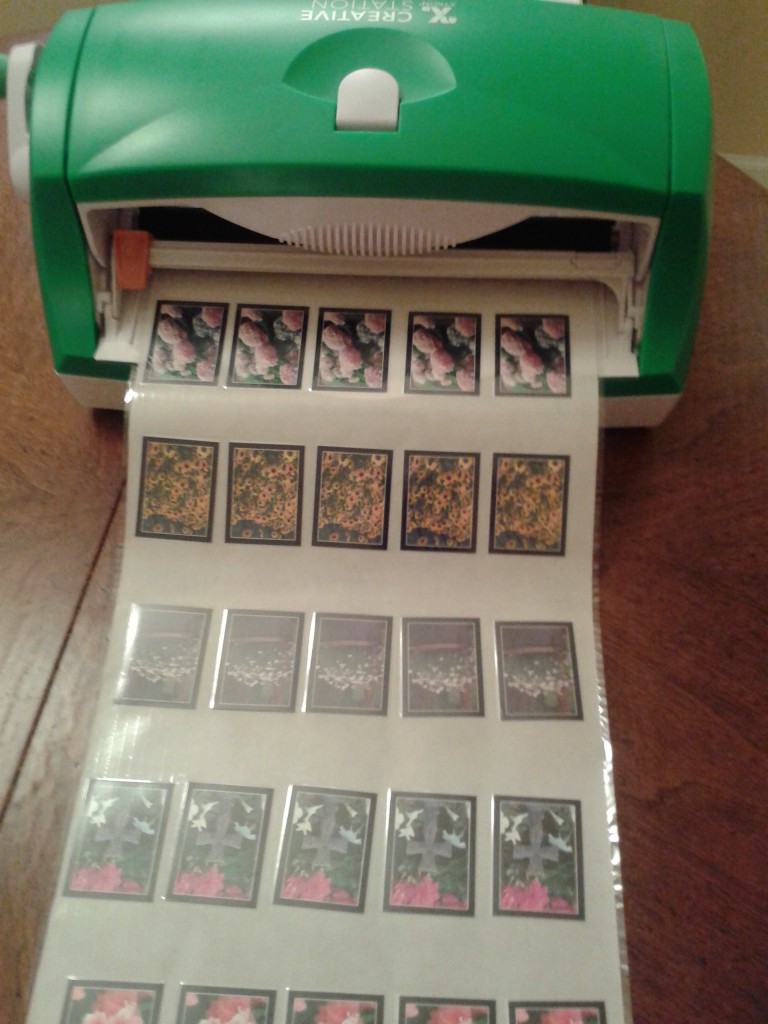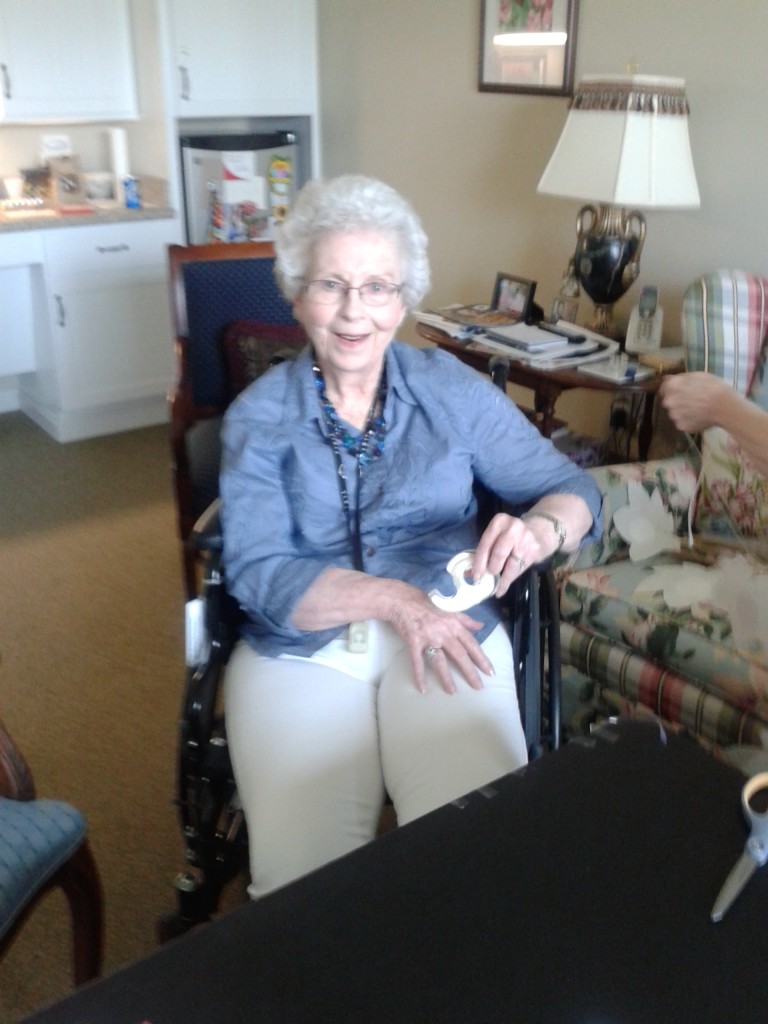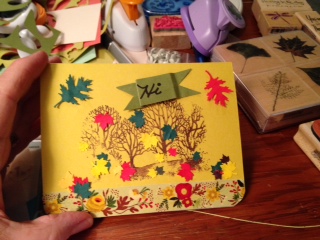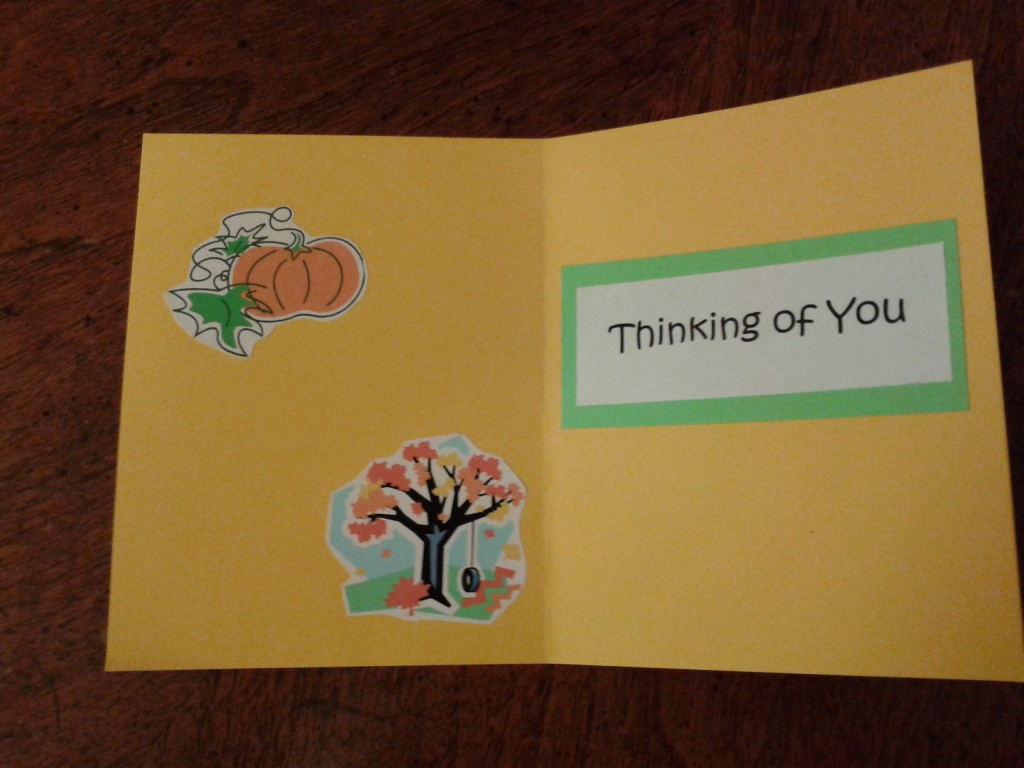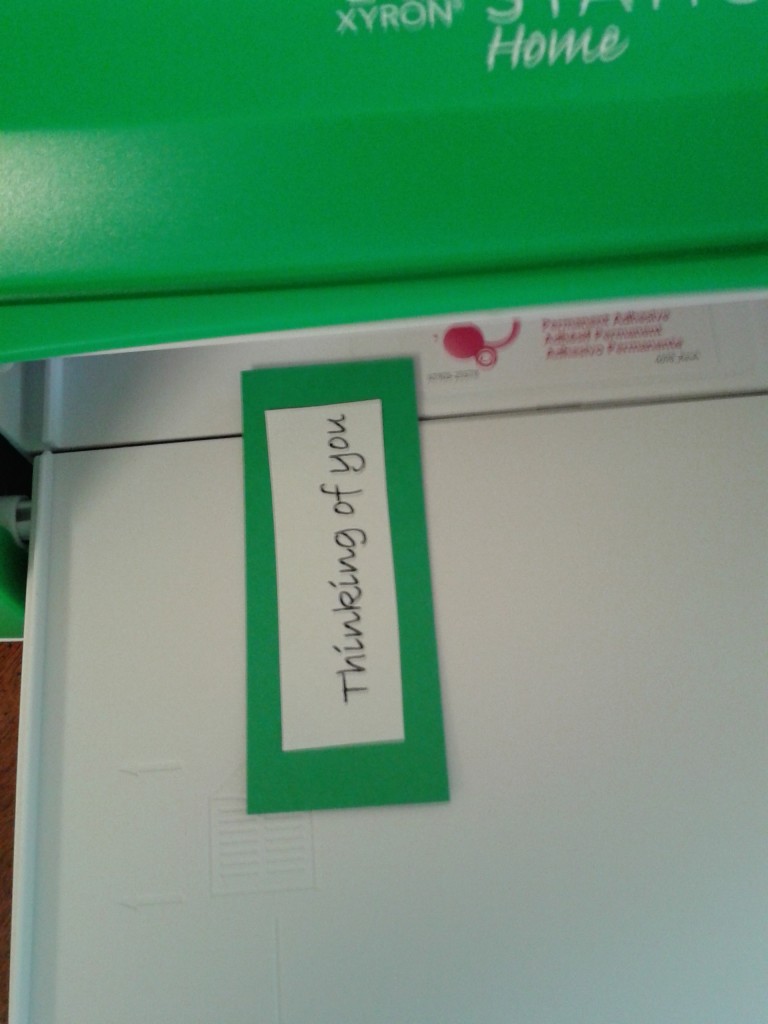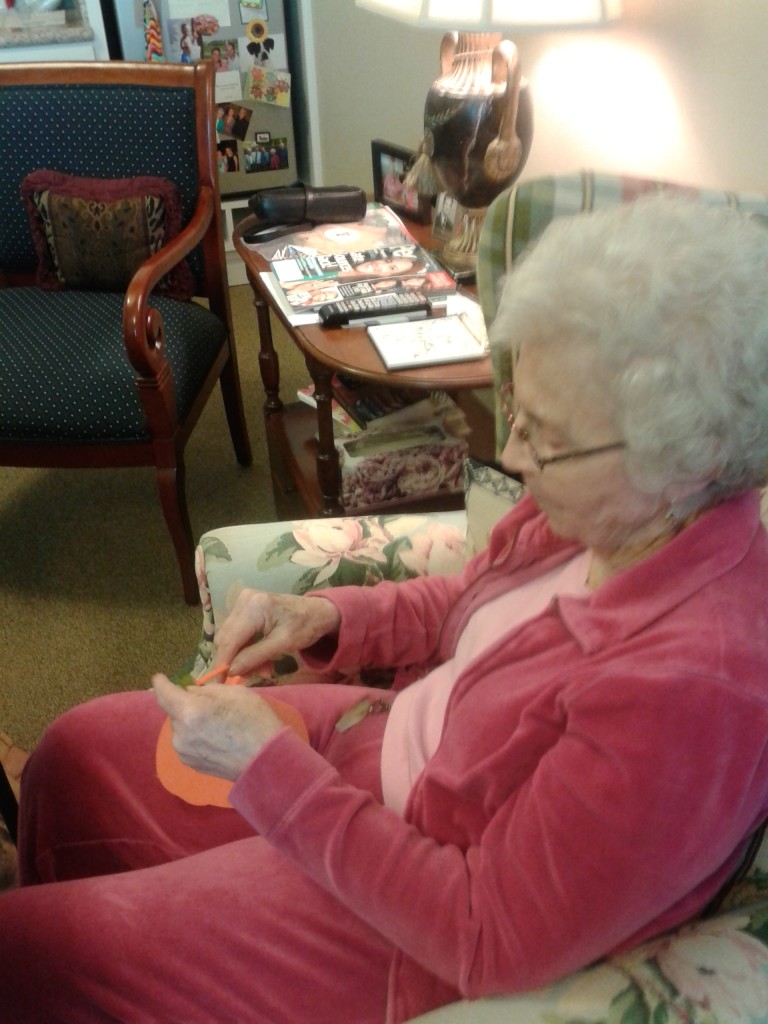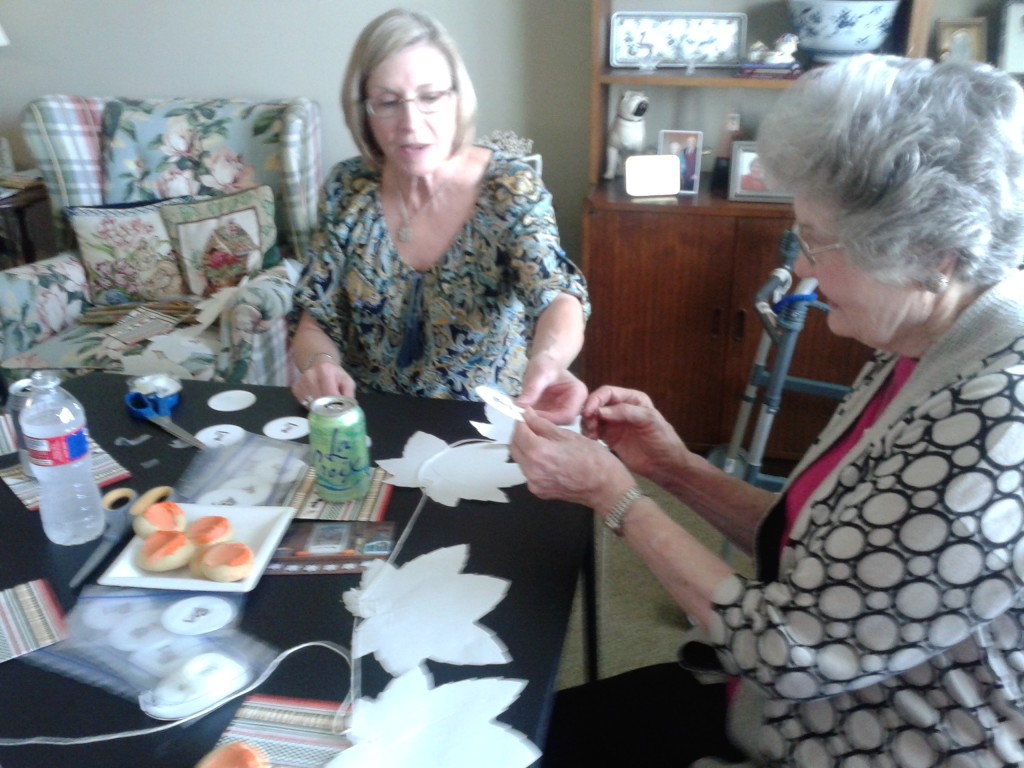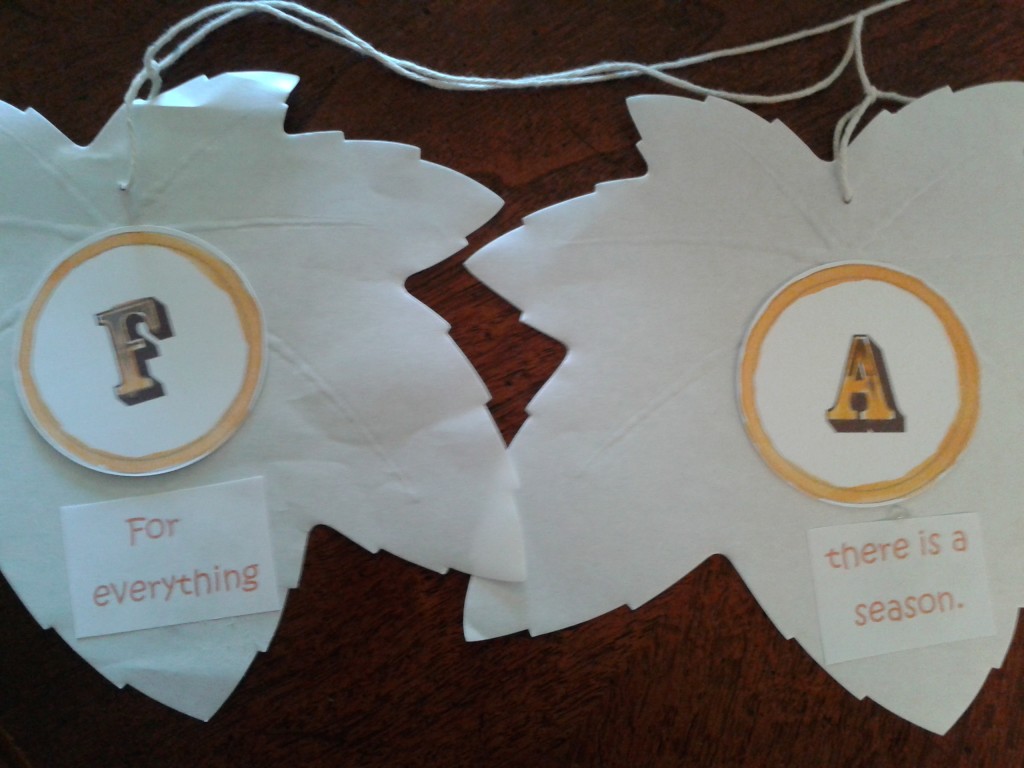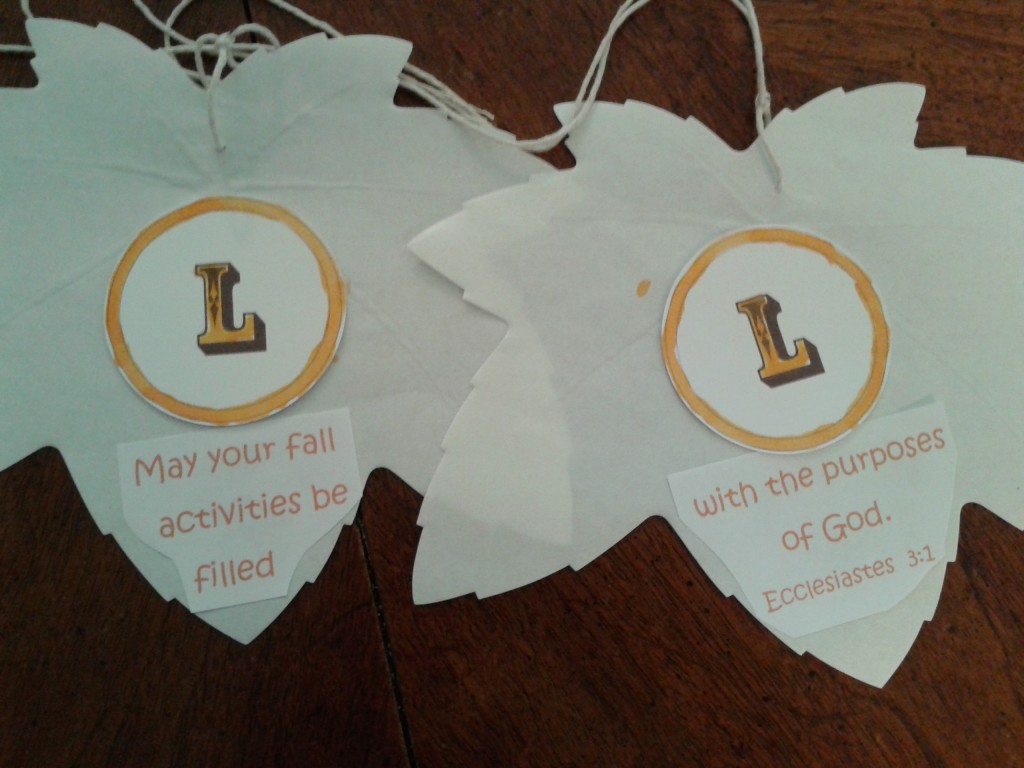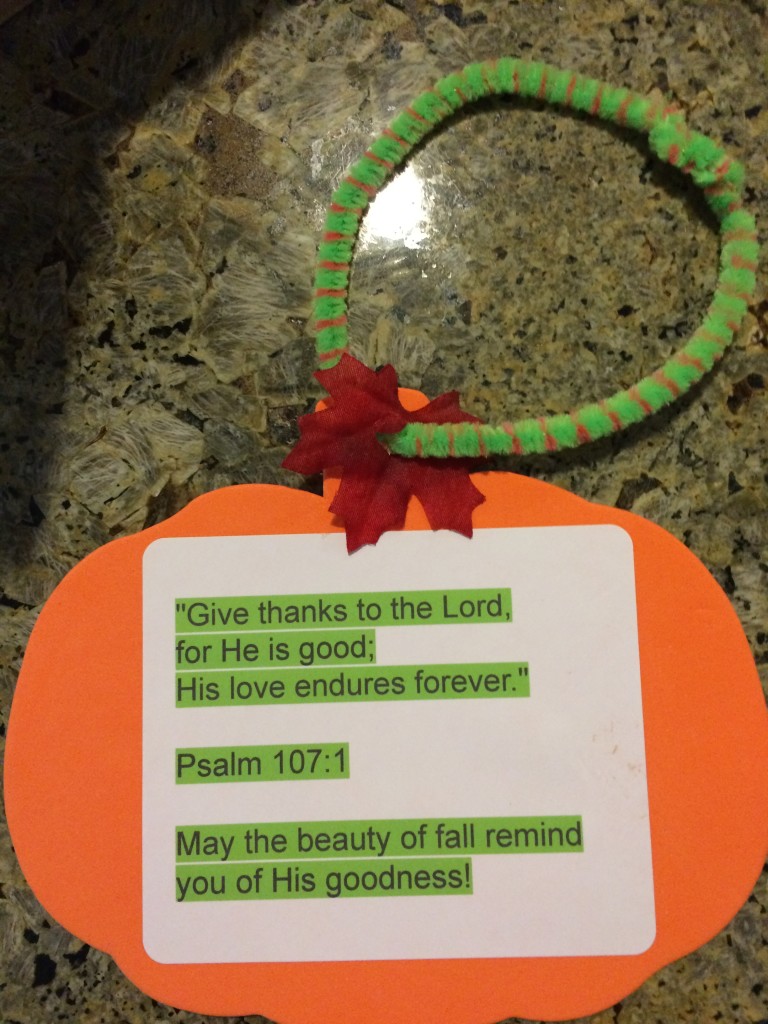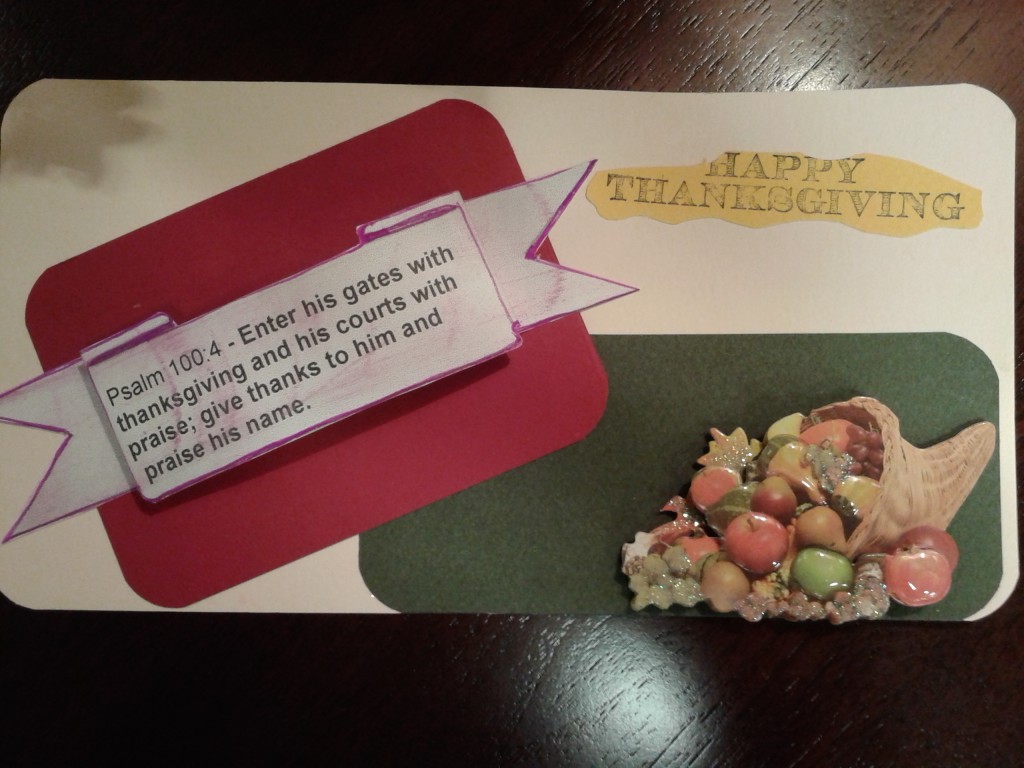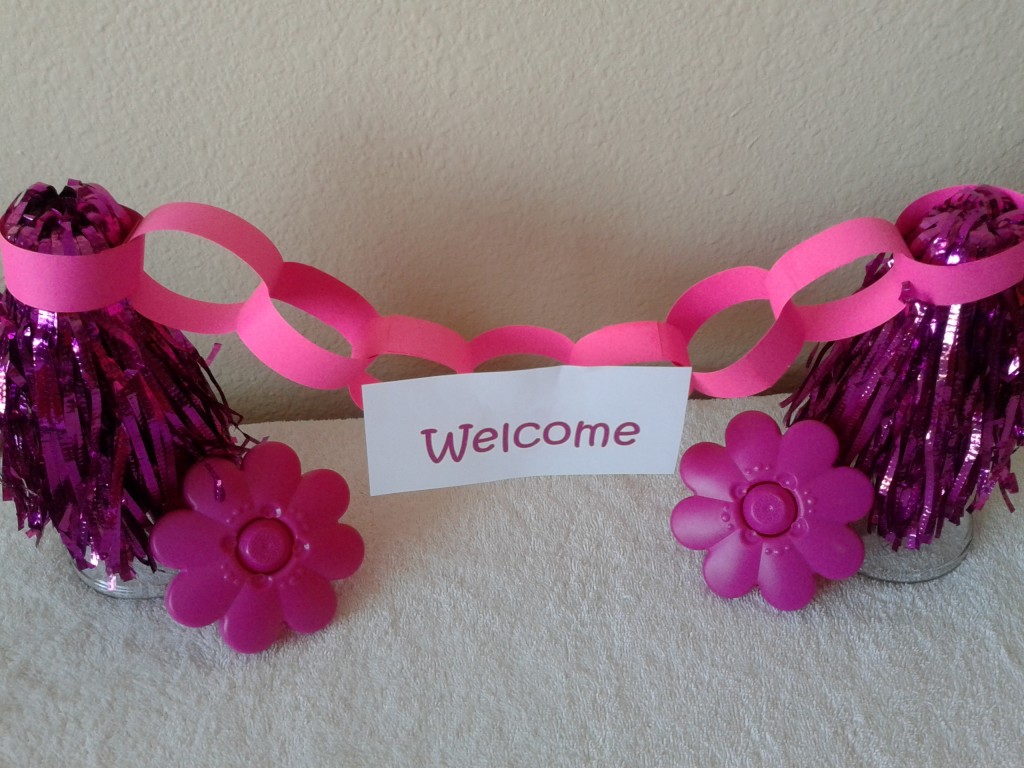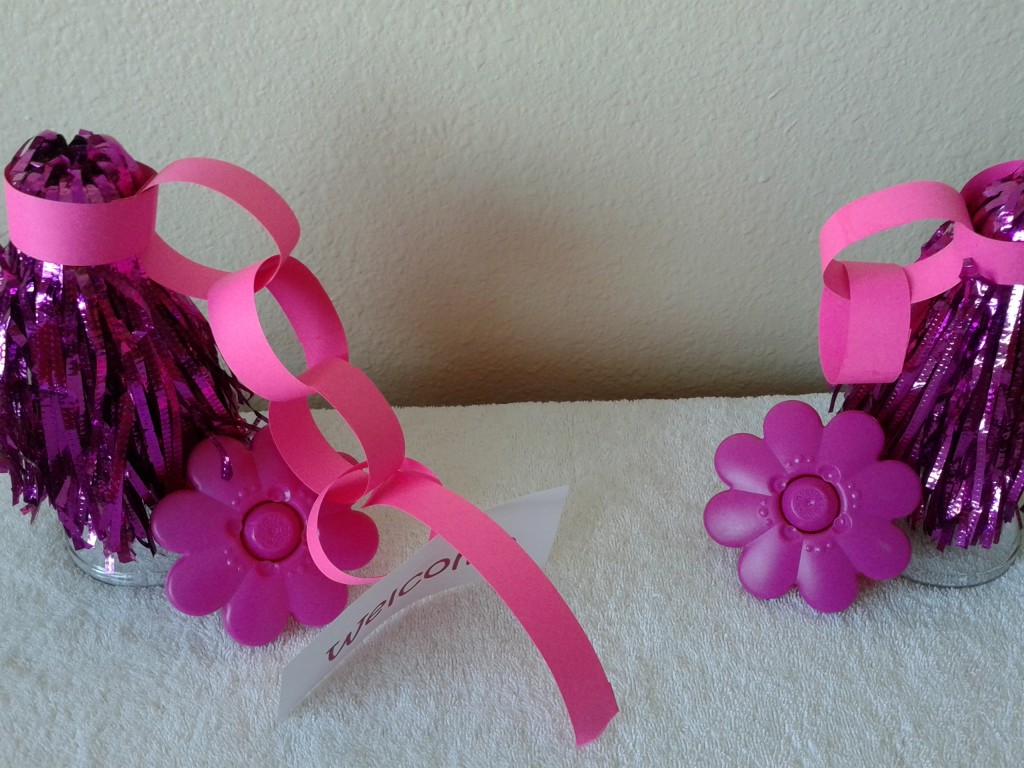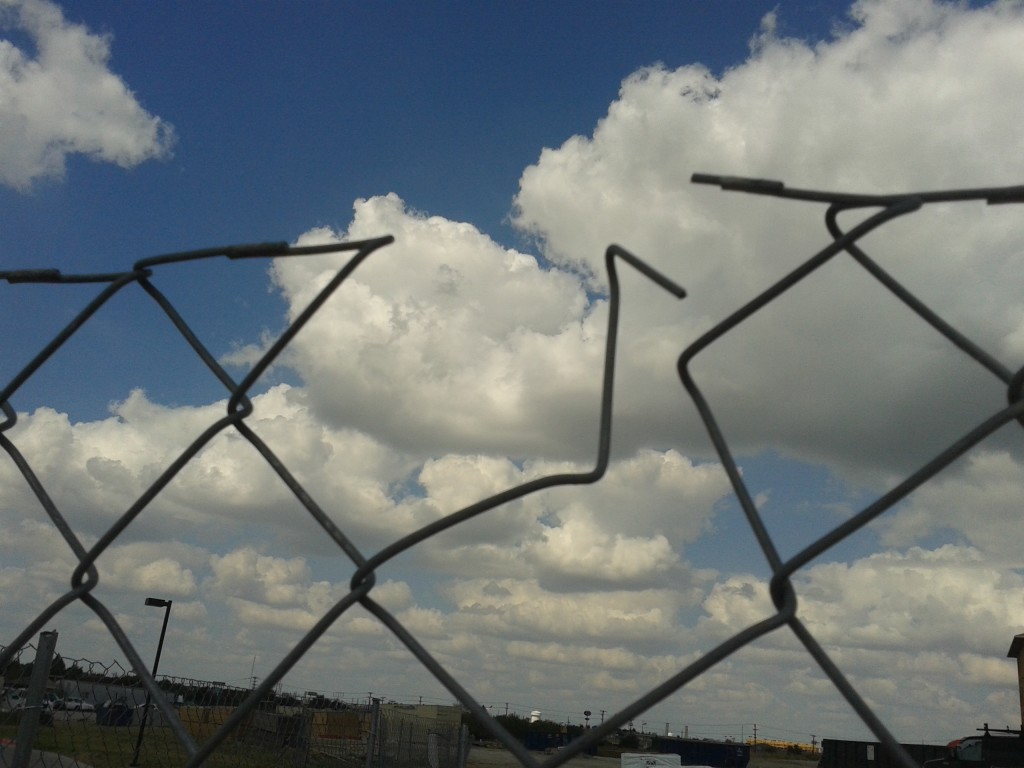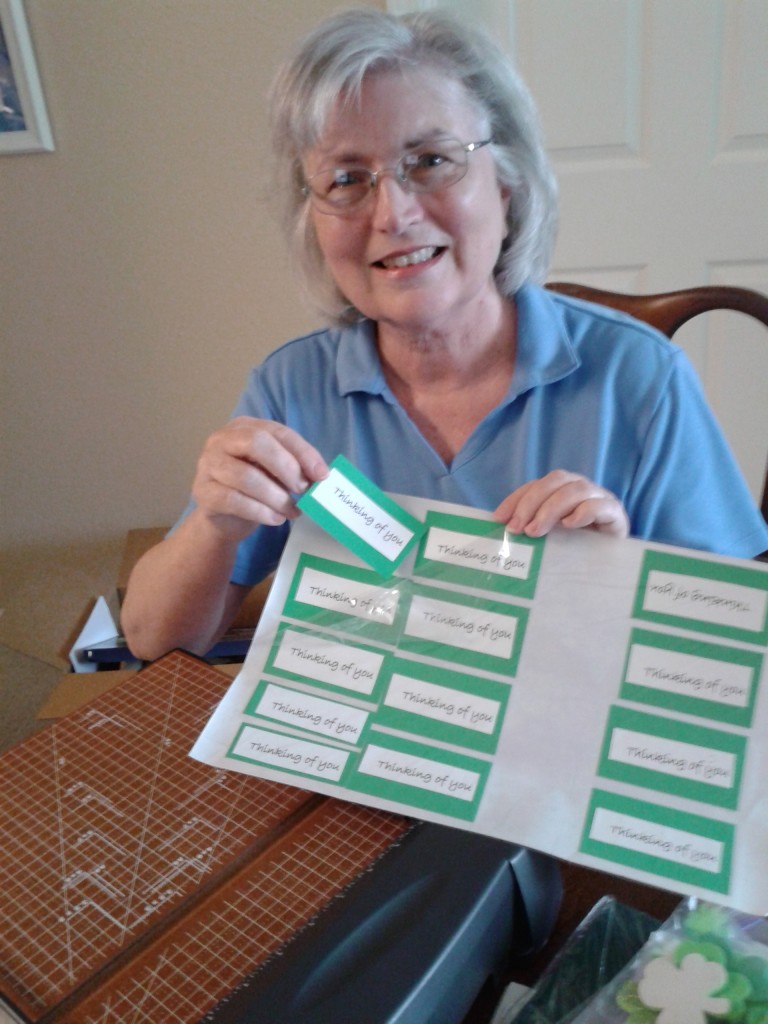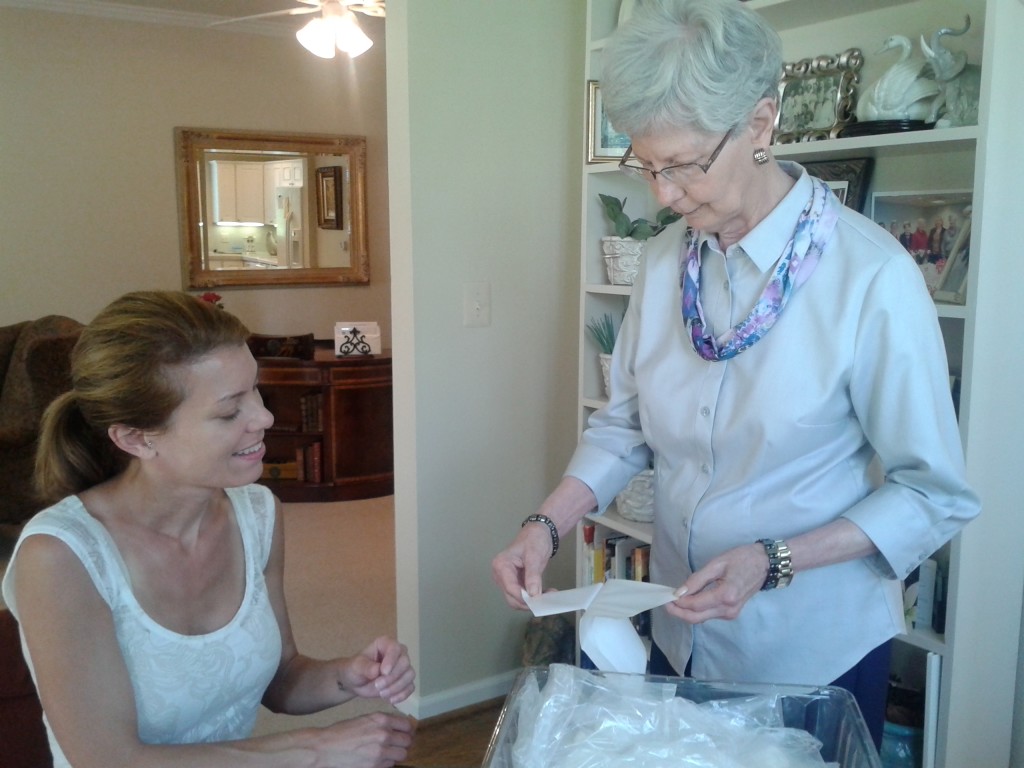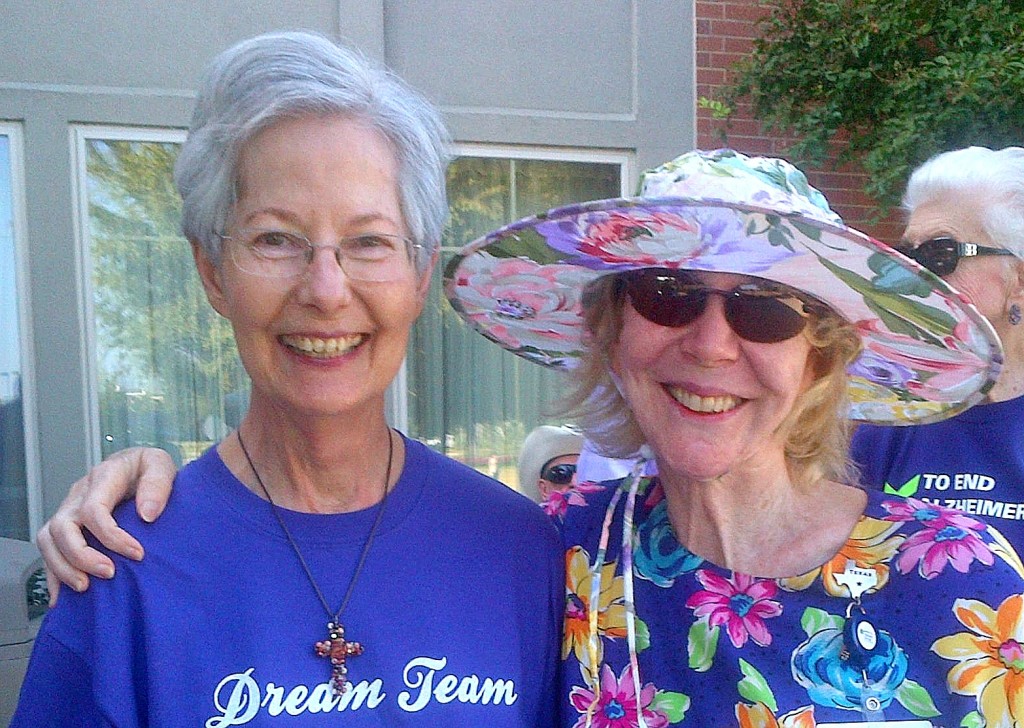Lady-Links have reason to celebrate, and you can get a sense of the joy and excitement we shared at our Second Anniversary Party by watching this video. In the past two years, we have made almost 300 visits bringing love and laughter into the lives of five dear ladies, all of whom are diagnosed with some type of dementia. Celebrate with us as you watch!
Dementia and Friends: Two Years of Visits
Lady-Links is an organization composed of ladies who visit their friends with dementia, engaging them in activities they can enjoy and successfully complete. We just celebrated two years of service and acknowledged how our group has grown from visiting one friend to visiting five friends. It was an Anniversary Party that resulted in love and laughter as we shared memories from our visits.
Lady-Links began when the husband of a person with Alzheimer’s dementia expressed the desire for ladies to visit his wife to help with her adjustment to their recent move to a retirement community. That simple request sparked the idea for Lady-Links and the friendship visits we make. Going in groups of two or three to visit our dear friend in her apartment proved to be delightful for both our friend and for us. Her entire emotional outlook changed, her social skills improved, and she recaptured some of her cognitive skills such as occasionally reading aloud the verses on the cards we made.
During the past two years, we have made over 200 friendship visits to this dear friend, and have followed her from Independent Living to Memory Care where we continue to visit her regularly and enjoy participating in activities with her in that setting. She enjoyed the Anniversary Party and her Lady-Links are like family to her, as she is to us.
In addition to our original dear friend, we have three other dear friends we are currently visiting. All were able to come to our Anniversary Party to celebrate.
The cake and punch helped make our celebration a festive occasion.
During the celebration we had time to share memories, love and laughter as we reflected over the past two years. Our original intent is the same. We provide friendship visits to one individual at a time, focusing on her interests and abilities. We engage our friends in a variety of activities that help stimulate social skills and help make them feel a sense of value and significance. In addition to over 200 visits to our original dear friend, we have made over 80 visits to the others. Each visit is carefully planned and coordinated so that it will engage the dear friend we’re visiting in a meaningful way.
One of the groups is a Music Group that we call the Lady La-Las. We play hand chimes and sing while our dear friend who used to be a music teacher plays the piano and directs us.
We currently have one craft group, but previously had two until one of our dear friends with vascular dementia passed away.
The last group is a Making Memories group. We enjoy focusing on our dear friend’s answers while we all share memories in response to select questions.
We would love to help you begin a Lady-Links group with your friends who have dementia. You can find plenty of information to start a group by reading through the categories on this website, many of which are “how to” posts. If you have questions, don’t hesitate to contact us.
Your visits can make a significant difference in the lives of your friends, and you’ll find that you will enjoy the visits as much as they do. People with dementia deserve to continue to have activities that create meaning in their lives and to find reasons to laugh, love, and rejoice. You can make that happen, and one day you’ll be celebrating an anniversary of friendship visits just like we did.
Grandparents with Dementia and Grandkids: How to Make It Work
Grandchildren benefit from a healthy relationship with grandparents that brings significance and security into their lives during their formative years. Grandparents benefit by knowing that they still matter and are needed for who they are, not for their achievements which are quickly diminishing as they face their twilight years. Enjoying activities together is a mutually beneficial situation for both grandparent and grandchild.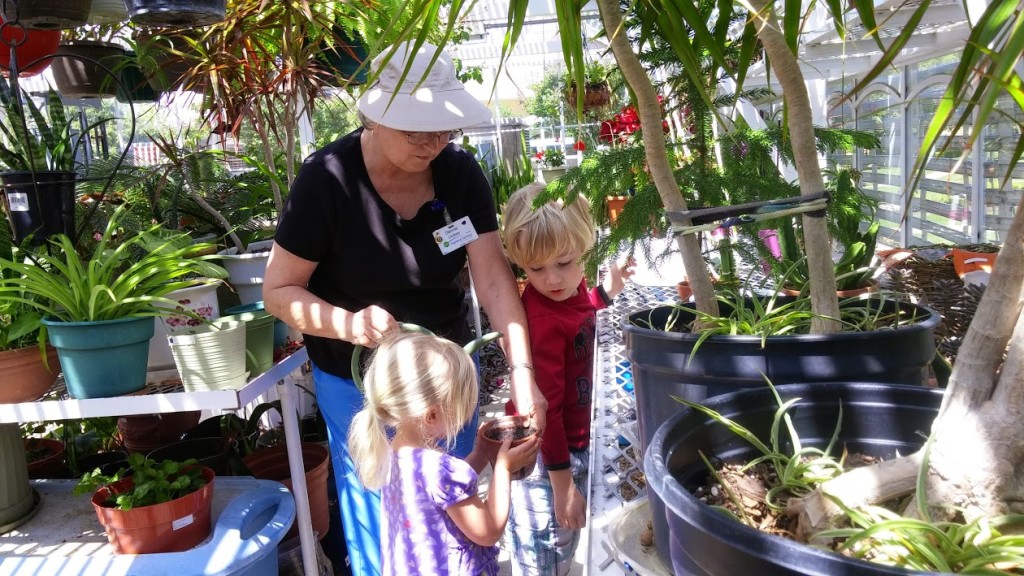
Today because we are living longer it is not uncommon for children to have grandparents and great-grandparents still alive. As a result, it is not unusual to find Alzheimer’s or a related dementia in many families. 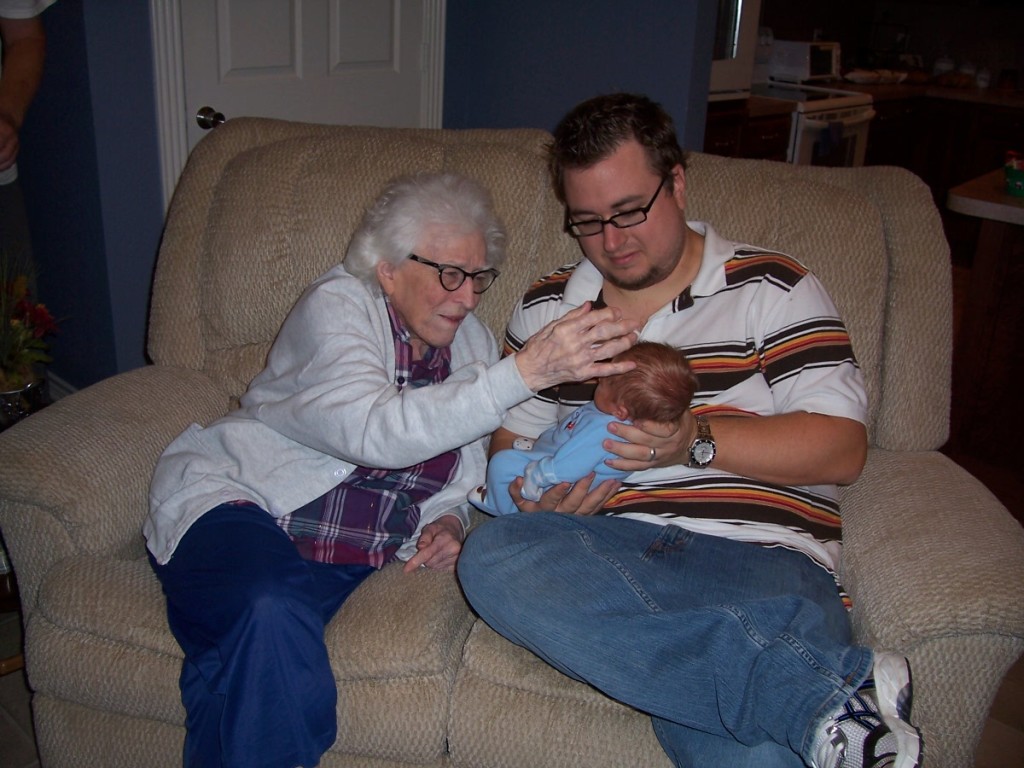
According to the Alzheimer’s Association, 1 in 9 Americans over the age of 65 has Alzheimer’s and one-third of Americans over age 85 are afflicted with the illness. Should these grandparents and great-grandparents be any less important to their grandchildren than those without Alzheimer’s or a related dementia? Of course not.
Those grandparents with dementias can continue to contribute to the emotional security and significance of their grandchildren. It is important to remember that the confusion/memory loss/cognitive decline doesn’t define who the person really is. Their character, experiences, faith, and temperament still have significant contributions to make to others, including their grandchildren.
And in return, the grandparents with dementia continue to deserve to have experiences in their lives that create meaning and to find reasons to laugh, rejoice and love. What better way to achieve this than with a grandchild? It just takes a little help from you, the parent of the child, to make it work.
TIPS FOR PROMOTING LASTING LINKS BETWEEN KIDS AND THEIR GRANDPARENT WITH DEMENTIA
- Prepare your child for what to expect. Talk honestly with your child about his or her grandparent. Use age-appropriate language to explain that the grandparent’s unusual behavior, such as asking the same question several times, is part of an illness. Let them know that this is not an illness that they can catch or that they caused.
- Prepare yourself for what to expect by becoming educated on the nature and progression of the dementia. Grandpa may have been a scratch golfer in his day but to play 18 holes at your local club now would be overwhelming. A better choice of activity would be going to the driving range, a putting green or to a miniature golf course. If that is too much, try Wii Golf or one of the putting cups that can be used at home.

- Prepare activities that both the child and the grandparent will enjoy doing together and can successfully complete. Grandpa may have organized deep sea fishing trips for the whole family at one time, but today his love for fishing can be acknowledged in a more realistic setting like fishing from the bank. Have the rod and reel ready to be used so that the activity can be easily accomplished. Be sure to have several backups handy so he doesn’t have to try to untangle a backlash or replace a lure on the spot. Grandpa may not have the skills to work quickly under pressure as he once did. Prepare ahead of time for that possibility and have what is needed readily available.
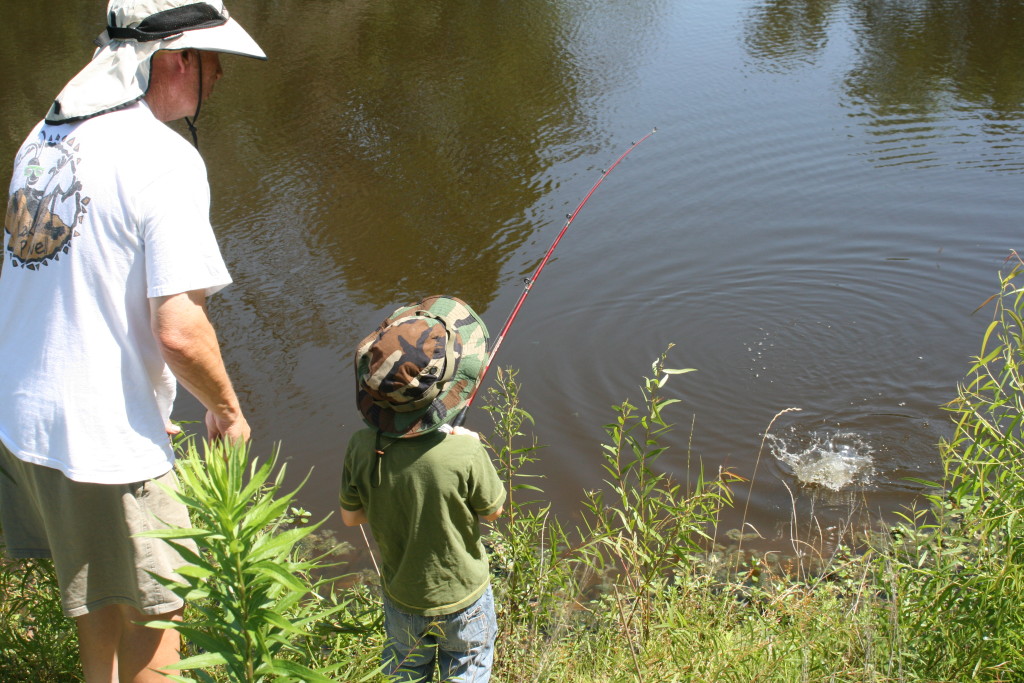
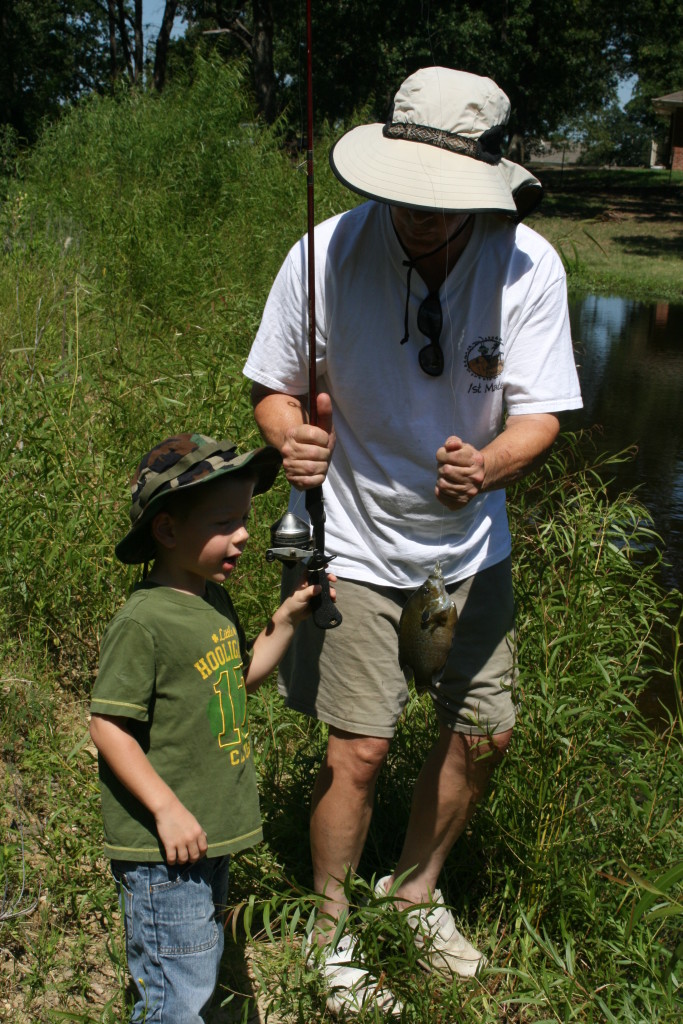
- Prepare to supervise as needed. Stay close enough to assist if needed, but not so close that you are an active participant. Remember, this is bonding time for the grandparent and grandchild, but because of the effects of the dementia, you will want to be alert and available.

- Prepare to be amazed as you witness links developing between the grandchild and the grandparent in areas of belongingness, togetherness, significance, security and fun!
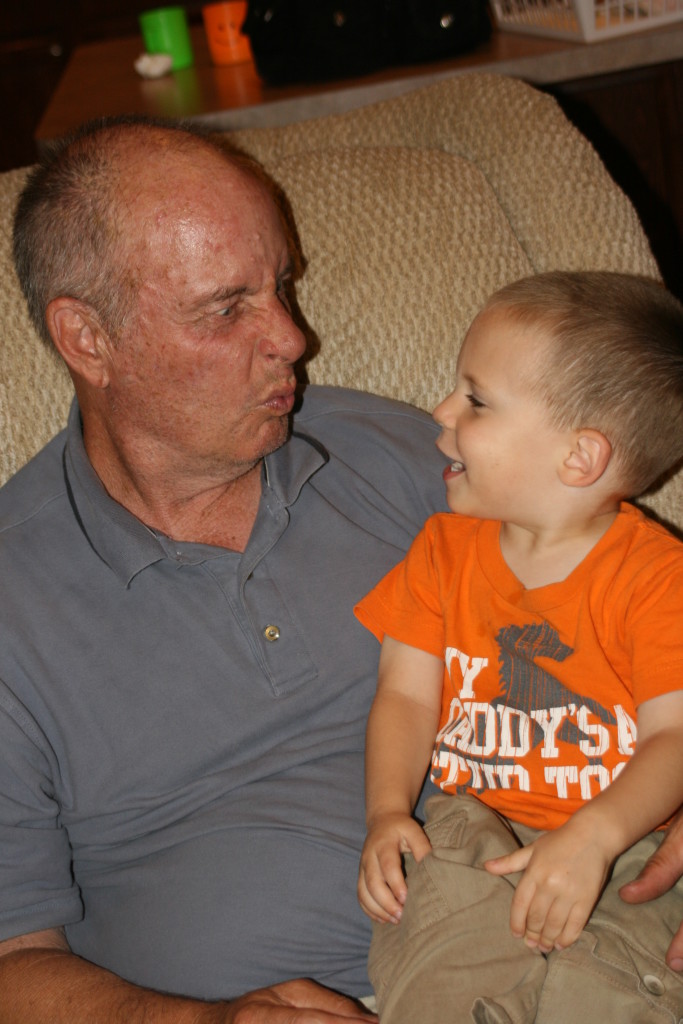
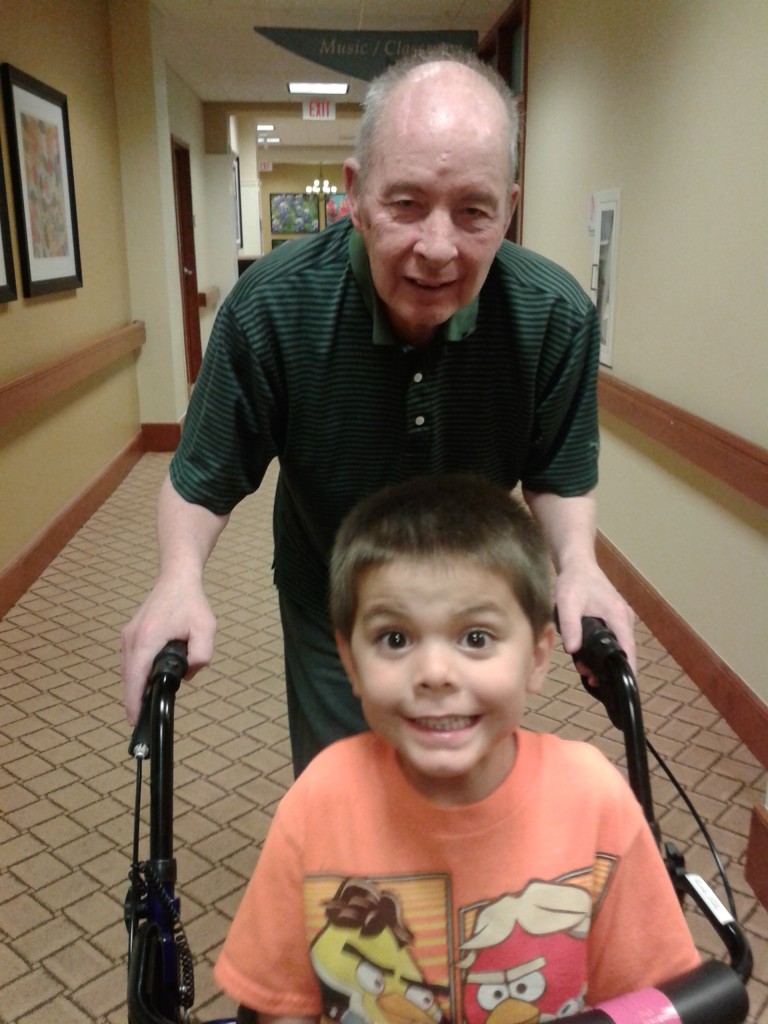
Preparation is the key. Prepare your child, yourself, and the activities. When you do, you will be helping to create links that last a lifetime. 
Dennie Lindsey is the creator and administrator of Lady-Links, a group that makes visits to friends who have dementia. She produces a newsletter, a FaceBook page and this website, all designed to promote an understanding and awareness of the types of activities that can be used successfully with those who have dementia. 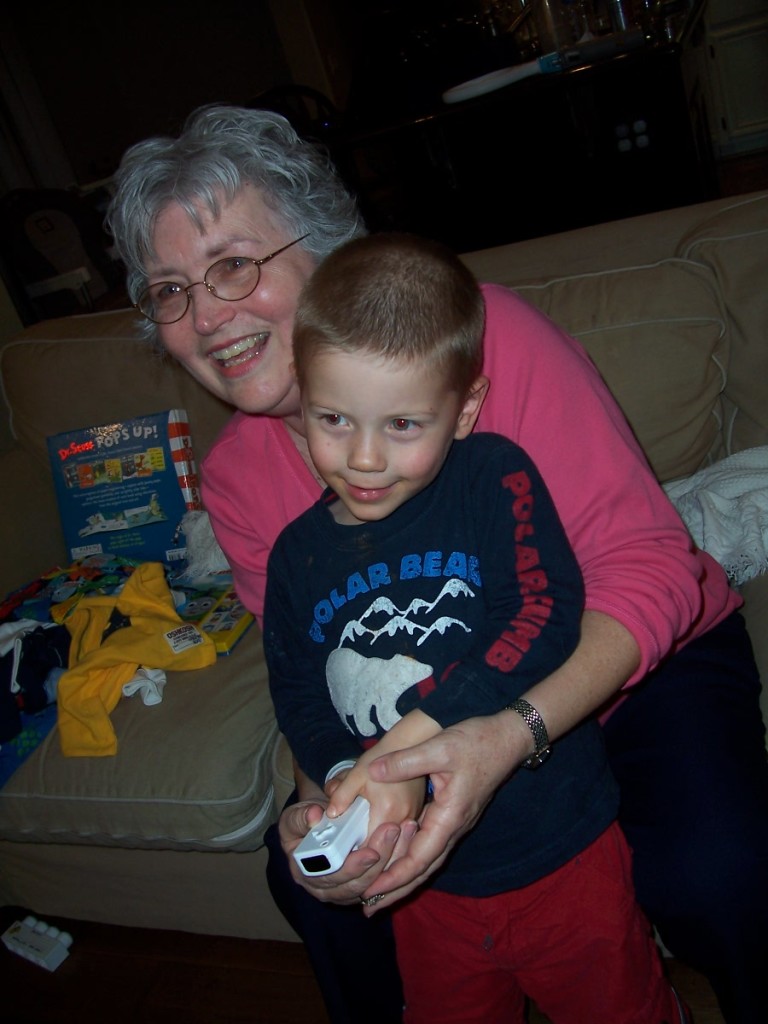
To read the entire original post about grandchildren connecting with grandparents who have dementia that Dennie Lindsey wrote click here.
Dementia and Winter Activities: Bringing the Outdoors In
Snow. Fun for those who can get outside and make memories with their creations.
But having fun and making memories in winter aren’t limited to going outside in below freezing weather. During this season, Lady-Links found plenty of ways to engage in cold weather activities while staying warm and inside. We created cards and door hangers with a winter message while we looked outside and admired the snow from a warm, cozy advantage.
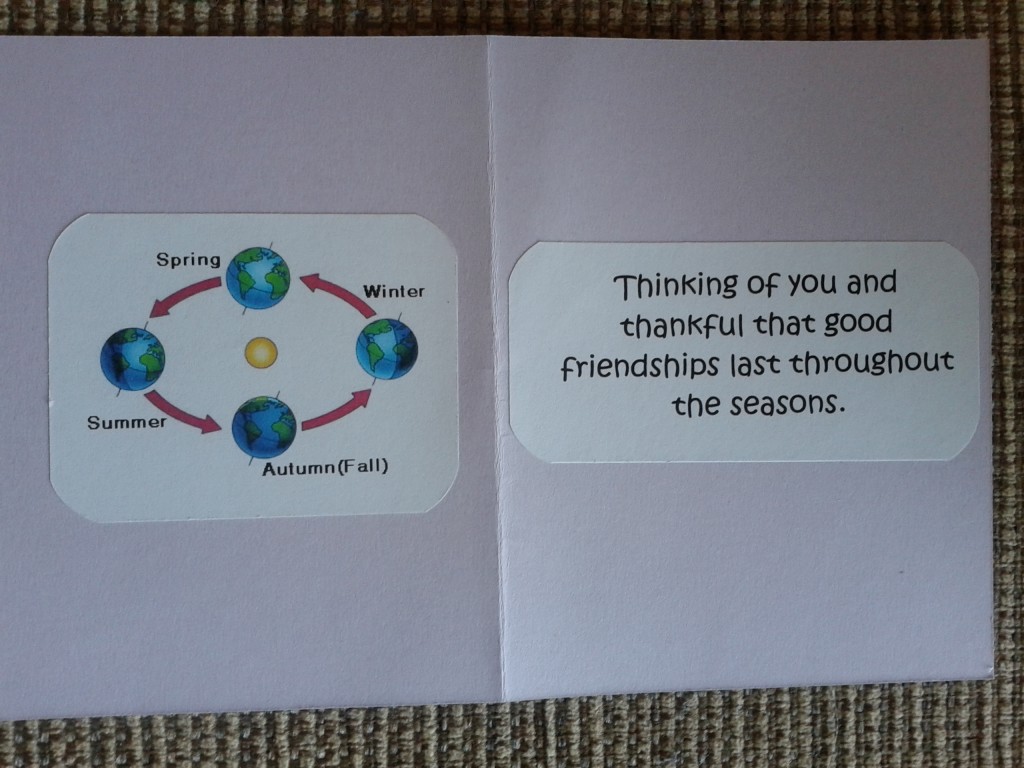 This card design worked well to bring the sentiments of the season into a friendship message.
This card design worked well to bring the sentiments of the season into a friendship message.
Here’s the card design for you to download.
We also made two winter blessing door hangers. One was a craft we ordered from Oriental Trading and the second was one we made from card stock and previously received Christmas cards.
If you would like the verse we used, you can download it here. We used it on the front of our original door hanger and on the back of the other one.
Of course, we prepared our crafts so that they would be easy to manipulate when we visited our friend with dementia. All the pieces to make one completed door hanger were placed in a baggie. Organizing it that way is less confusing than dumping out all the pieces and having to look for which part is needed. The foam adhesive-backed snowflakes were hard to punch out from their backing in the craft that we ordered, so we did that part before the visit and had them in place.
From our cozy environment, we enjoyed the craft and the “feeling” of being a part of the winter season. The window blinds were closed for the picture, but when opened and during the time it snowed, the view was that of a winter wonderland. It was the best of both worlds!
The conversation was rich as we shared memories from our childhoods of snowy days while completing the door hangers.
When we finished, we had plenty of Winter Blessings to give away to others, helping them to celebrate the season too!
Friends with dementia can enjoy each season regardless of the outside temperature or weather-related problems with an appropriate seasonal craft and related discussion topics. How did you help your friend or loved one with dementia connect with winter?
Dementia and Birthdays: Tips for Celebrating
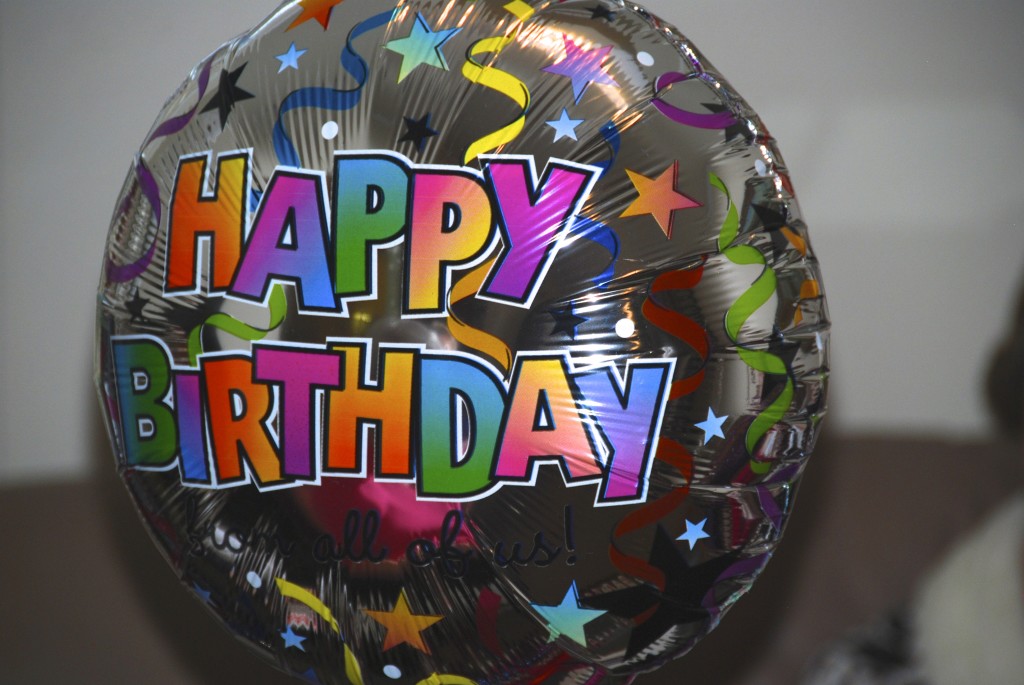 Our friend with Alzheimer’s dementia was about to have a birthday, and we knew we could plan an awesome celebration for her based on the success of the one we gave her last year. We decided to use the same “Simple yet Significant” stratigies because they worked so well. Such a strategy keeps us focused on our friend’s needs and gives us a starting point for our planning. All birthday parties need food, activities, gifts, and friends to make it a real celebration. However, for a person with dementia, each of those elements needs to be modified so that he or she can enjoy and engage in the event. After all, it is for them! Here’s how we did it:
Our friend with Alzheimer’s dementia was about to have a birthday, and we knew we could plan an awesome celebration for her based on the success of the one we gave her last year. We decided to use the same “Simple yet Significant” stratigies because they worked so well. Such a strategy keeps us focused on our friend’s needs and gives us a starting point for our planning. All birthday parties need food, activities, gifts, and friends to make it a real celebration. However, for a person with dementia, each of those elements needs to be modified so that he or she can enjoy and engage in the event. After all, it is for them! Here’s how we did it:
Tips to Make It Simple
Guests: Choose a limited number of friends and family who are knowledgeable about dementia and who have a supportive relationship with the birthday person. They should be encouraging, kind, compassionate, patient, and know how to bridge communication gaps with smiles and flexibility. They should be ones who feel at ease with your loved one or friend and who have an ongoing established relationship with that person. This is not the time to introduce new acquaintances. Guests should have the understanding that those with dementia have worth and value, and are to be treated with dignity and respect.
Games: Choose activities in which the person with dementia can participate and enjoy. Keep the person’s skills and abilities in mind by selecting games in which he or she can be easily and successfully engaged. Favorite games that have been a part of the person’s routine prior to the birthday party are always good choices. Some favorite games and activities are easily modified to include a birthday theme with simple changes such as with color or design. For example, if you do a balloon toss, consider using a balloon with a birthday message. If you do a painting activity at the party, consider painting birthday themed objects. If you play Bingo, consider using a birthday themed set.
Gifts: Choose to limit what guests can bring and communicate that well in advance of the party. If guests are to bring presents, a gift list of things that the person with dementia will recognize and can use would be very helpful. Decide whether presents should be wrapped or unwrapped. Sometimes the birthday person is in need of a specific major item and the guests can give toward that item prior to the party. That item can be displayed, wrapped or unwrapped, with a group card attached and presented at the appropriate time. Sometimes bringing a birthday card rather than a gift is the best choice. Each card can be opened at the party by a hostess who reads a few lines from the card, acknowledges the sender, and then gives it to the birthday person to place in a box or basket to keep.
Tips to Make It Significant
Favorites: Choose theirs, not yours. Their favorite things should be included rather than what is typical or traditional and should be reflected in all the party involves.
Familiarity: Choose a setting or location, as well as games and guests, that they know so they won’t be distracted by something unusual or unfamiliar. Trying something new or being surprised in a group setting may cause inappropriate behavior, anxiety, or withdrawal.
Feelings: Choose what is fun for them and will make them feel comfortable They should feel at ease with all that takes place. Provide opportunities for plenty of love and laughter in ways that they can understand. Be flexible and have several alternatives.
How we applied these tips at the recent birthday party we gave for our friend with Alzheimer’s dementia:
Guests
We have 24 trained Lady-Links, but we all agreed that 24 would be an overwhelming number, so we asked for 11 volunteers to come plus her husband and her son. She recognized each one of her Lady-Link friends since we visit her twice a week in groups of two or three, and have been for over a year. She was very at ease and interacted with great enthusiasm.
Games
The first game we played was a modification from the Bingo Game we made for her birthday last year. However, in a year’s time, she is not as interested in Bingo as she once was. Rather than pack away the game, we put it to good use by distributing one of the Bingo caller’s cards to each person. Each card was a clip art version of one of her favorite things.
As this year’s hostess pointed to one of the cards, such as a picture of a cup of coffee, she asked, “Is coffee your favorite thing?” Everyone who was a coffee drinker raised his or her hand. Then the hostess had to narrow the field by asking additional questions based on her knowledge of our friend and her habits. For example, the hostess said, “Is drinking coffee black your favorite thing?” That narrowed it even more. Then the hostess said, “Is having your friends over twice a week to visit you and drink coffee your favorite thing?” Of course, our friend’s hand was the only one left up.
As the game continued, we would sometimes need to prompt our friend to hold her hand up. There were 12 catorgies with questions (favorite food, favorite music, favorite ways to spend time, etc.) all based on her favorite things. Every time she “won” the category she was given the card with the picture on it that represented the category. The “winner” at the end of the game was the one who had the most cards. Of course, she did, and the prize was a chocolate bar (one of her favorite things.)
Our friend loves music, especially that of Perry Como. We played one of his CDs and repeated what we do at many of our Lady-Link visits…we played balloon toss and danced.
Her son joined in the fun! We told him that we knew where he got his dancing skills….from his mom! She really is a great dancer.
Gifts
We determined that actual presents could be confusing and require too much time to open and admire, so we asked each Lady-Link to bring a birthday card which was opened and read aloud (just the main message, not word for word) by the Lady-Link Hostess. As the hostess read the main part of each card and the sender’s name, it was passed to our friend and, after a momentary glance, her son helped her put it in a basket to keep.
Favorites
Chocolate is her favorite, so of course the cake and icing were both chocolate!
Coffe is her favorite drink, and it was graciously served by her husband.
Familiarity
The party was held in her home so she would feel comfortable in her surroundings. If her home were not available, I would have chosen a place that she was familiar with and would feel secure in so that she would feel at ease. Plus I would have chosen one that would not have interruptions or people who were not connected to our group.
Feelings
We kept the entire celebration to less than one hour and provided plenty of opportunities for fun. There were no speeches, nor putting her on the spot by expecting her to respond publically to any of the activities, such as when we read the cards we did not stop and wait for the typical “thank you” response. She is unable to respond at that level and we would never, never call attention to that. We provided plenty of opportunities for her to enjoy without any type of pressure or stress. Her family appreciated our efforts to make this a party in which she was fully engaged, filled with joy, and made to feel appreciated, valued, and loved.
Celebrating birthdays of those with dementia can provide opportunities to enrich their lives and yours. Just remember to keep it “Simple yet Significant” and you’ll have success!
How do you celebrate birthdays with your friend or loved one who has dementia?
Dementia and Making Valentines: Tips for A Successful Project
Exchanging valentines is a great way to let friends know that you care about them. For the past two years, Lady-Links visits in late January and early February have included making our own special valentines to share with our neighbors in the retirement community where we live. We’ve created a variety of encouraging messages and designs to our decorated hearts and cards and all have been enthusiastically received.
We added a jeweled valentine to our group of favorites this year, inserted a ribbon of heart designs and made it a door hanger.
We always include a set of valentines with scripture that are distributed at our Vespers service.
Working with so many designs can be confusing for our friends with dementia, so we work on one project at a time, complete it and put it away before we begin the next. Of course, there is plenty of prep work that is done before each visit so that it ready to be assembled.
The valentines with the jewels are packaged in individual kits that we purchased from Oriental Trading Company. All the pieces are stickers, including the jewels. However, the small jewels were hard to peel and stick, so we added those before the visit, leaving only large pieces for our friend with dementia to assemble.
We also added the ribbon before the visit because that was a little difficult to tie. The assembly of these valentines went very smoothly because of our prep work and they look great hanging on the residents’ doors.
With all of our valentine projects, we package all the pieces for one valentine together in a baggie. That way, everything is ready for assembly.
We use stickers rather than glue whenever possible because managing the glue container and distributing the correct amount can be hard for our friends with dementia. If something has to be glued, we do that in our advance prep work before the visit.
If we can’t find a sticker that fits our design, we use our Creative Station Sticker Machine to make exactly what we want, such as the scripture hearts.
Our friends with dementia had a wonderful time during these past few weeks as we made the valentines. Much of the success of the project was because we selected an activity that was meaningful to our friends since it brought back such lovely childhood memories, and it mattered to them today because they knew the valentines we made were to be given to those who needed a touch of encouragement in their lives. The prep work we did ahead of the visit provided a stress-free activity that was filled with lots of laughter and love.
Did you do any special valentine activities with your friend or loved one who has dementia? We’d love to hear about it!
Dementia and Self-Worth: How to Improve
There are a number of studies that show that people with dementia continue to have feelings similar to those without cognitive impairment. They need to feel a sense of accomplishment and a sense of purpose. As their friends and family members, we need to provide activities for them that create meaning in their life. Lady-Links visits attempt to do just that. One of our friends we visit has Alzheimer’s dementia. The other has vascular dementia. Both ladies need meaningful interaction with a sense of purpose that they are contributing to something more than just themselves. We have found that making cards to give to others is one way to meet that need. We seldom send the card ourselves. Rather we make cards and give them to groups to use when they learn of someone who needs some encouragement. There are many groups who welcome our cards. Most of the cards have scripture because that is the request of one of our friends with dementia. Some of the cards don’t include scripture and can be used for occasions where just a cheerful message is what is needed. We have over 30 card designs from get well messages to St. Patrick’s Day and everything in between that have been successfully completed at our Lady-Links visits.
We even make “repurposed” cards. We have collected previously used cards, cut the front off and added stickers of scripture and pictures to the backside.
Since both of our friends with dementia need to have projects that are easy to assemble, we have found that printing the message on labels or making stickers using a sticker making machine is better than using glue. They can both peel and stick, so rather than using glue, we use the “peel and stick” method whenever possible. At other times we use double sided tape.
We have learned that an uncluttered design is what our two friends need. When there are too many choices or too many shapes and sizes, they feel overwhelmed. Some designs that are very artistic in our way of thinking are too confusing for our friends. The following two pictures are beautiful but were too complicated for our friends to assemble.
The project must be about meeting the needs of our friends, not us. Although we have many of the same needs, they must be met in different yet appropriate ways. So we adjusted our card designs to reflect what our friends with dementia can appreciate, understand, and help make. And the cards have turned out beautifully and are greatly appreciated by those who receive them.
Before each visit, there’s prep work that must be done. We get the cards to the point where they can be easily assembled when the visit occurs .
With the parts of the card ready to be put together, our friends can enjoy the process, feel a sense of accomplishment, and know that their efforts will be used to encourage another person’s life.
Feelings of accomplishment help our self-worth. But even more importantly, accomplishing something that will benefit others fulfills our need to provide meaningful significance in someone else’s life. With the card projects, our two friends with dementia get a sense of having contributed in a positive way to the encouragement of others.
If you have friends or loved ones with dementia, how do you help them find a sense of purpose and accomplishment in their lives? What activities promote an improved sense of self-worth in them?
If you want help or suggestions on how to start a Lady-Links group in your area, please let us know. We would love to help you get organized and give you ideas for making friendship visits to the one you care about. Most likely you will see, as we have, improved social skills and an improved sense of self-worth. It takes such little effort yet it makes a big difference…in their lives and in yours!
Dementia Friendship Groups: Now there are two!
We have TWO reasons to celebrate!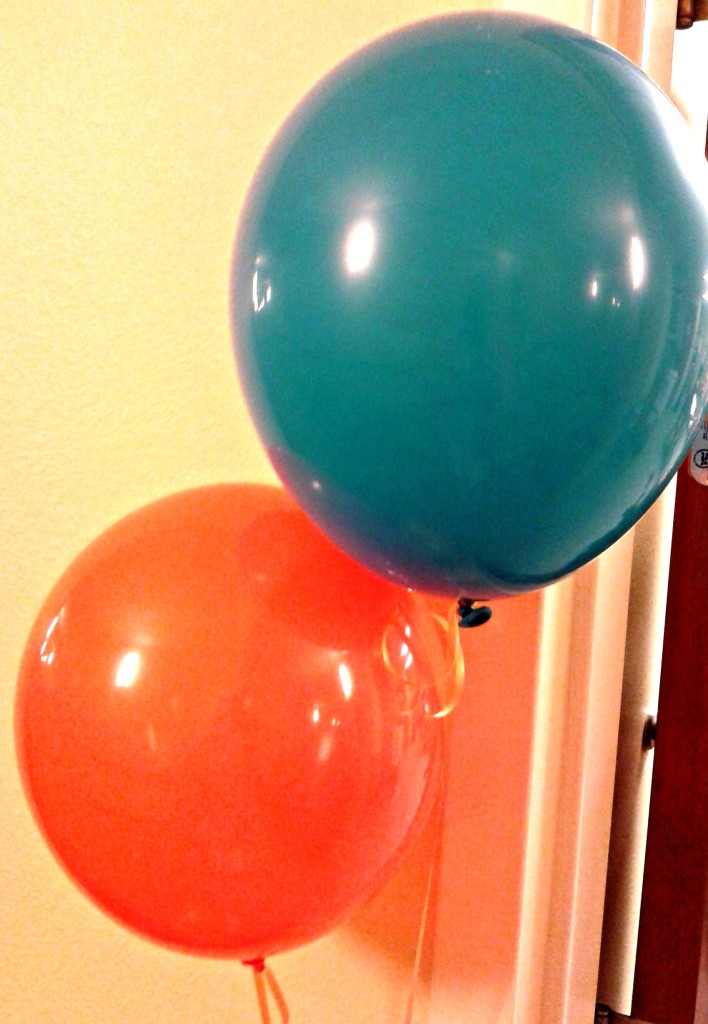
The original Lady-Links group involving 14 ladies who make friendships visits to our friend with Alzheimer’s dementia has made over 130 visits and is still going strong, incorporating new activities to meet the needs that a progressive disease brings. But there’s another reason to celebrate as well. We are very excited to announce that a second Lady-Links group has formed making visits to a friend who is diagnosed with vascular dementia, caused by a series of mini strokes known as TIAs.
The new Lady-Links group includes 10 ladies who visit in groups of two or three on Monday afternoons for one hour in our friend’s assisted living apartment. Visits are scheduled a month in advance, with each lady scheduling one visit per month. Our new friend is an artist who, before her dementia diagnosis, painted beautiful pictures some of which decorate her apartment. One of my favories is a bluebonnet field, although I enjoy all of them each time I visit.
We are learning that there is a vast difference between our two friends, which shouldn’t be a surprise since they have two distinct types of dementia and are at different stages in their progressions. Our new friend communicates well but short term memory difficulties sometimes affects what she says. Her artistic skills are greatly diminished from what she once could do judging by her beautiful paintings displayed so nicely in her home, but she still has a marvelous eye for color and design. And she knows what she wants communicated on the cards and projects that we do with her at each visit.
For example, at a recent visit when we made 15 of these fall banners to share with others, our friend was quick to point out that they weren’t colorful enough. Plus, because her faith was very meaningful in her life before her diagnosis, and we found out still is, she wants a scripture worked into the design. That was good news to us because we organize each group of Lady-Links around one person, meeting their needs in ways that are significant to them. If she wanted color and scripture added, we were glad to know that so we could incorporate what was meaningful to her into the existing project as well as into future ones.
So, of course we took her suggestion to heart and added color and scripture.
It took an additional visit to get the banners the way she wanted them, and we learned a valuable lesson. With our new friend, her cognitive skills are strong enough that she can give input on the projects and activities we are planning but she is unable to communicate specifics. We take her ideas and make them work by turning them into a project or craft she can do and feel good about giving to others. She feels like she is contributing significantly (and she is) to these projects and to the lives of those in our retirement community or in the post acute care section of our community who receive them. Once we had an idea of what she wanted, the visits have gone smoothly with designs that meet her goals.
The daughter of our new friend described her mother’s attitude since her involvement with Lady-Links as “the happiest I’ve seen her in years.” Her daughter went on to tell us that her mother looks forward to each visit with “great anticipation.” We do too! The visits are enjoyable and filled with lots of love and laughter as we work together. Our friend is cognizant enough to engage in conversation about memories that these projects inspire, such as from her childhood or early adult years. It is a blessing for each of us to be involved in these visits. We enjoy them as much as she does.
We would love to add “more balloons” to our photo gallery when we hear of additional Lady-Links groups that have started. Are you interested in organizing a Lady-Links group for your friend or loved one who has dementia? It takes someone to serve as the coordinator, getting together the people who visit , keeping the schedule of who is to visit on which day, and arranging for activities. You can look at our blog posts for activity and project ideas or choose your own. Let us know how we can help you help your friend maintain the important links that bring joy and meaning into their lives during this very critical time. We’d love to turn our celebration of “two” into a “three” and then a “four and more” as new Lady-Links groups form.
Alzheimer’s Research: Lady-Links Walk for the Cure
Our Lady-Links group has made friendship visits for over a year to our friend who has Alzheimer’s dementia, so we have first-hand knowledge of how this disease progresses. We are committed to encouraging our friend and enriching her life throughout each stage. What we all hope is that a cure can be found that will one day prevent others from the toll that Alzheimer’s takes on the patient, their family and friends. Our group was represented in our community’s local walk to help raise donations for continued research that will provide the cure that is so needed.
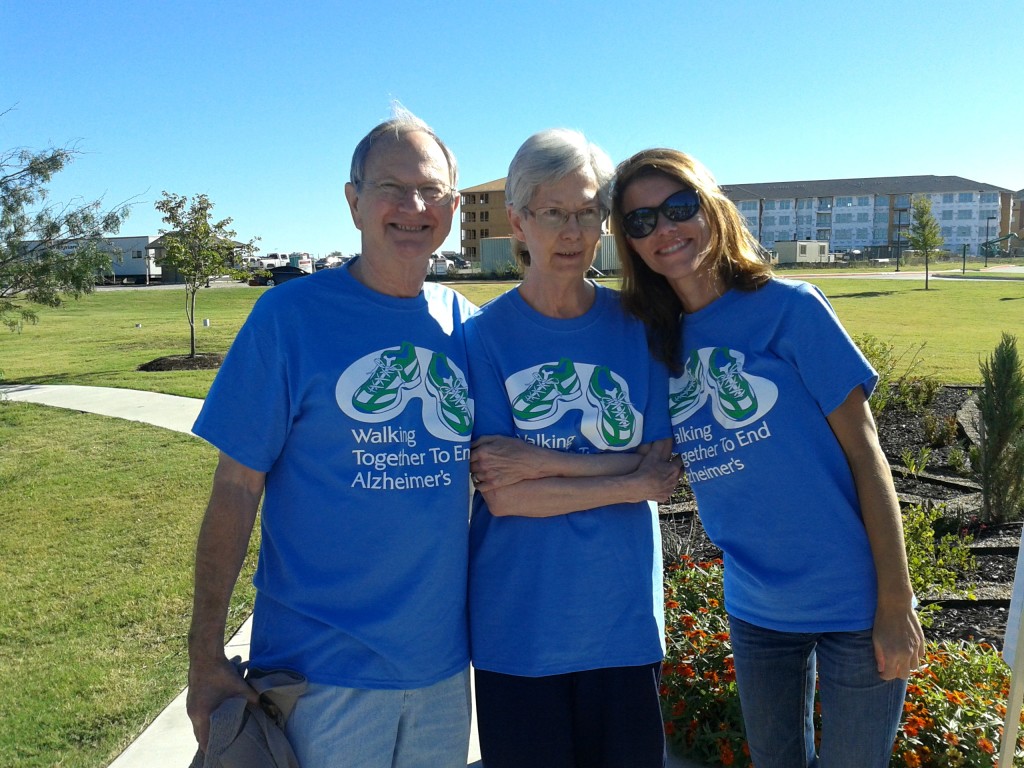 At the reception following the walk, we celebrated!
At the reception following the walk, we celebrated!

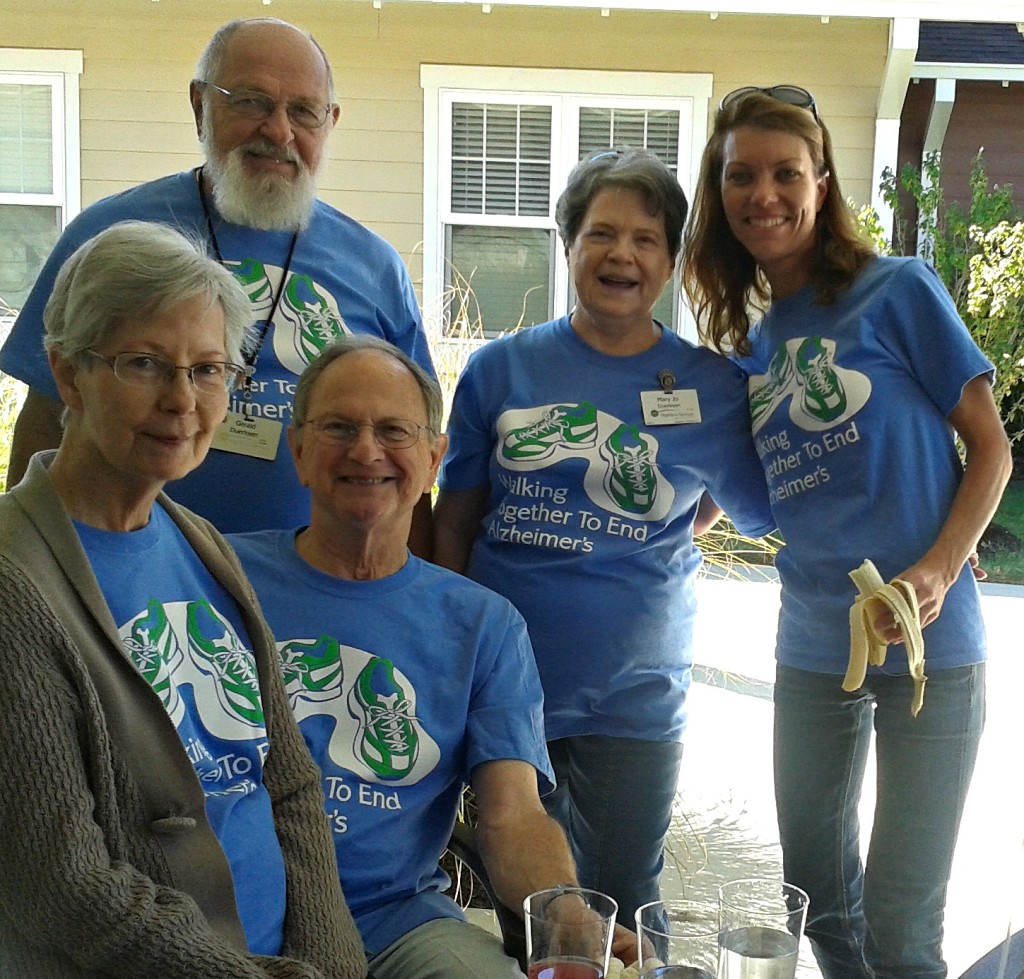 Our group helped raise funds for continued research. Before the weekend was over, this check had to be re-written to include added donations.
Our group helped raise funds for continued research. Before the weekend was over, this check had to be re-written to include added donations.
It was very fulfilling to be a part of a group effort for such a worthy cause. If you know a person with Alzheimer’s dementia, think of what you can do to help. You’ll feel good about your decision and your support will be greatly appreciated. Together we can make a difference!
For more information on how to start a Lady-Links group in your area to make visits to your friend or loved one, just let us know. We’re here to help you get organized!
Dementia and Losing Life’s Links: How to Help
A link is used to connect one thing to another. We find links in every area of our lives: social/emotional, spiritual, intellectual and physical. All of these are important areas in which we need to make appropriate connections to help us navigate our way through life. When those “links” are in place, the message is clear.
What if some of those links became damaged or destroyed? The message wouldn’t be so clear, would it?
Without a clear message, your ability to link people, places, and concepts begins to vanish. You would probably feel lost, alone and insecure. You would be thankful for those who helped you find your way in this difficult situation.
Most of us know someone who is unable to make those types of links or connections without some help. Think of how it might feel if that person were you. Were you ever in a new situation where you didn’t fully understand what was happening? Were you ever traveling in new territory and lost your way? Did you ever struggle with one of your courses in school and think you could never “get it” let alone “master” it? What if it were like that most of the time? Now can you relate to the confusion that a person with dementia has?
Perhaps only a small portion of the links are destroyed or damaged in the early stages. But the amount of affected brain cells continues to increase, destroying those connecting links necessary for making sense of things, until the person diagnosed with dementia is in a state of confusion much of the time.
Rough, huh? But confusion/dementia/cognitive decline doesn’t define the person. Their character, experiences, faith, and temperament still have significant contributions to determining who that person is. They are our fathers, grandfathers, mothers, grandmothers, our spouse or perhaps a dear friend. They have been loving parents, spouses, and siblings. They have been college professors, astronauts, homemakers, teachers, professional athletes, you name it. Dementia crosses all boundaries. They are still Aunt Sally or Uncle Joe and continue to deserve to have activities that create meaning in their life and to find reasons to laugh, rejoice, and love.
Want to relate to a person with dementia? Engage in an activity that you both can enjoy.
Plan it in such a way that your friend will successfully be able to participate fully in whatever his or her part is. It will improve their quality of life by making them feel a sense of accomplishment and contributing to their overall sense of well-being.
You can find appropriate activities throughout this blog that our Lady-Links group has done with our friend who has Alzheimer’s dementia. Try our activities the next time you and/or your children visit that special person in your life. You have a wonderful opportunity to help maintain a link to past interests and give that person a chance to be more engaged with life.

